Cacti are some of the most fascinating and diverse plants in the world, thriving in some of the harshest environments. With their unique shapes, vibrant flowers, and remarkable ability to store water, they have become popular choices for both indoor and outdoor gardening. There are many types of cactus plants, each with distinct characteristics, ranging from towering saguaros to tiny, round pincushion cacti. Whether you’re looking for a drought-tolerant addition to your garden or a low-maintenance houseplant, there’s a cactus species perfect for every setting.
Exploring different types of cactus plants reveals an incredible variety of forms, colors, and sizes. Some cacti, like the Prickly Pear, feature flat, paddle-like pads, while others, such as the Golden Barrel Cactus, grow into striking, round shapes covered in dense spines. Many species bloom with spectacular flowers, adding unexpected bursts of color to their rugged appearance. Understanding the unique needs of each cactus type ensures that they thrive, whether in arid landscapes or as decorative houseplants.
This guide will introduce you to 85 different types of cactus plants, complete with pictures and names to help you identify and choose the best ones for your collection. From desert giants to compact indoor varieties, each cactus has its own charm and growing requirements. Whether you’re a seasoned collector or a beginner, learning about these incredible plants will enhance your appreciation for their beauty and resilience.
Different types of cactus plants
Saguaro Cactus
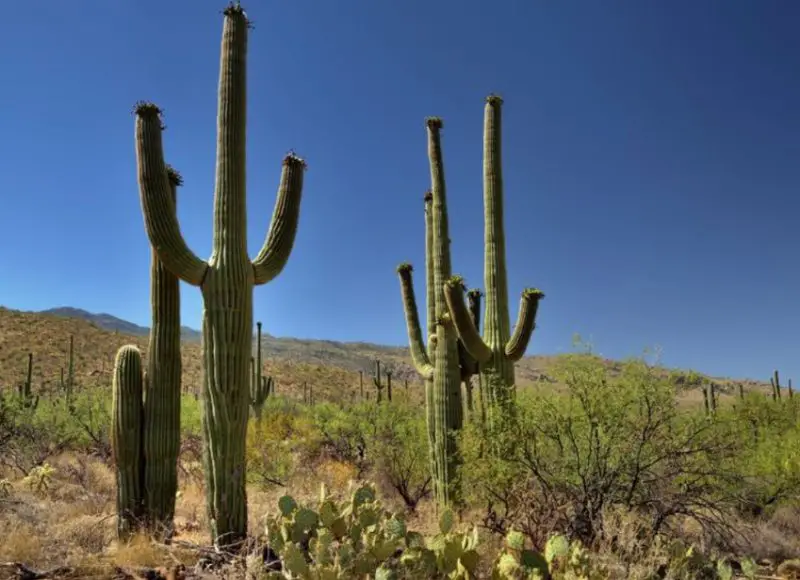
The Saguaro Cactus (Carnegiea gigantea) is an iconic symbol of the American Southwest, known for its towering height and arm-like branches. This slow-growing giant can reach up to 40 feet tall and live for over 150 years. Its thick, green stem is covered in protective spines, and it stores large amounts of water to survive the harsh desert climate. In late spring, it produces beautiful white flowers that attract pollinators like bats and bees.
Found primarily in the Sonoran Desert, the saguaro thrives in hot, arid environments with well-draining sandy or rocky soils. It prefers full sun and can tolerate extreme drought. This cactus is a vital part of the ecosystem, providing shelter and food for desert wildlife, including birds that nest in its trunk. Despite its resilience, saguaros grow very slowly, often taking decades to develop their first arms.
Golden Barrel Cactus
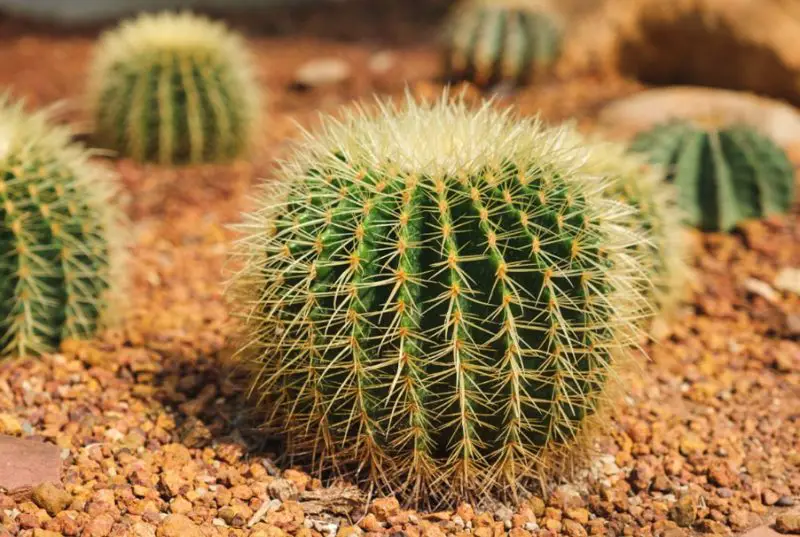
The Golden Barrel Cactus (Echinocactus grusonii) is a striking, globe-shaped cactus known for its bright yellow spines and symmetrical ridges. It can grow up to three feet in diameter, making it a popular choice for desert gardens and xeriscaping. During the summer, it produces small yellow flowers on its crown, though it typically blooms only when mature. Its spines help reduce water loss by providing shade and directing moisture toward its base.
Native to Mexico, the golden barrel cactus thrives in dry, rocky environments with minimal water. It prefers full sun and well-draining soil, making it ideal for arid landscapes. Although this cactus is relatively easy to grow, it is slow-growing and requires protection from prolonged cold temperatures. Due to habitat destruction, wild populations are now endangered, making cultivated specimens an important part of conservation efforts.
Prickly Pear Cactus

The Prickly Pear Cactus (Opuntia spp.) is known for its flat, paddle-shaped segments covered in clusters of tiny spines called glochids. This versatile cactus comes in various species, some growing upright while others sprawl along the ground. In spring and summer, it produces vibrant flowers in shades of yellow, pink, or red, followed by edible fruit called “tunas.” The fruit and pads are commonly used in culinary dishes, especially in Mexican cuisine.
Thriving in arid and semi-arid regions, the prickly pear adapts well to different environments, from deserts to coastal areas. It prefers well-draining soil and full sunlight, tolerating drought exceptionally well. This cactus provides food and shelter for wildlife while also being valued for its medicinal and nutritional properties. Some species can become invasive if not managed properly, spreading quickly through their segmented growth.
Christmas Cactus

The Christmas Cactus (Schlumbergera bridgesii) is a unique, tropical cactus that blooms around the holiday season, producing vibrant flowers in shades of red, pink, white, or purple. Unlike desert cacti, it has smooth, segmented stems without sharp spines. It thrives in humid conditions and prefers indirect light, making it a popular houseplant. With proper care, it can live for decades, producing beautiful blooms each year.
Native to the rainforests of Brazil, the Christmas cactus grows as an epiphyte on trees and rocks, absorbing moisture from the air. It requires well-draining, slightly acidic soil and benefits from regular watering, especially during its growing season. Cooler temperatures in fall help trigger blooming, making it an ideal plant for festive indoor displays. Unlike traditional cacti, it does not tolerate prolonged drought.
Easter Cactus
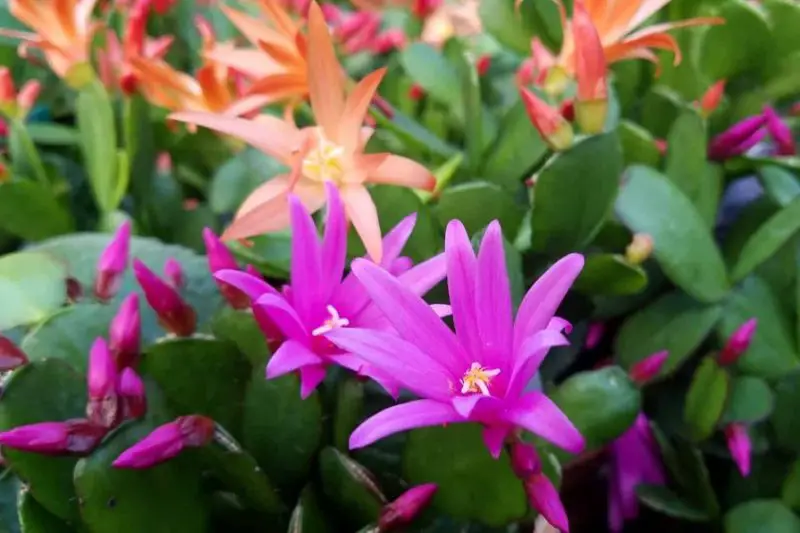
The Easter Cactus (Rhipsalidopsis gaertneri) is a charming, spring-blooming cactus known for its star-shaped flowers that appear around Easter. Its segmented, flattened stems are slightly scalloped at the edges, and unlike desert cacti, it lacks sharp spines. The flowers come in bright shades of pink, red, and white, adding a burst of color to indoor spaces. It requires consistent moisture and a stable environment to thrive.
Native to Brazilian forests, the Easter cactus prefers cool, humid conditions with bright, indirect light. It grows well in pots with well-draining soil and benefits from occasional misting. Unlike other holiday cacti, it has a distinct dormancy period in winter, which helps trigger its springtime blooms. Proper care includes regular feeding and avoiding sudden temperature changes, which can cause bud drop.
Bunny Ear Cactus
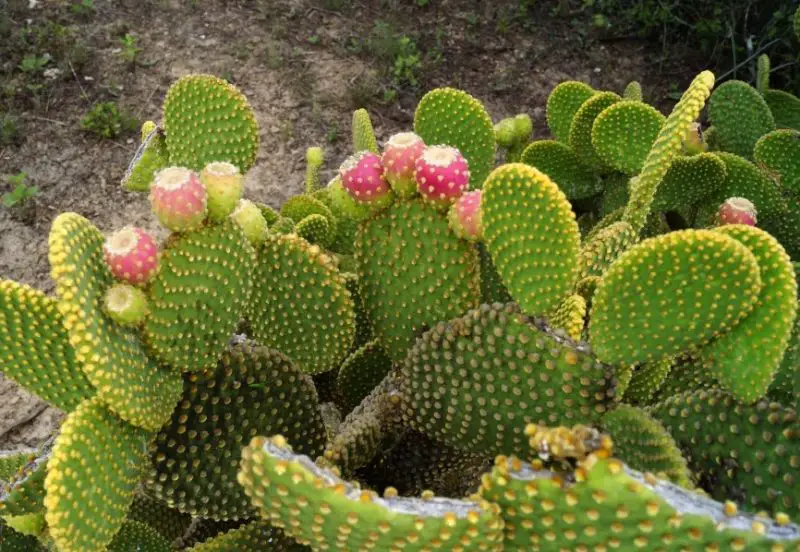
The Bunny Ear Cactus (Opuntia microdasys) is a small, charming cactus with oval-shaped pads that resemble bunny ears. Instead of sharp spines, it has tiny, hair-like glochids that can easily stick to the skin. It produces small yellow flowers in summer, followed by red fruit in the right conditions. This cactus grows in a compact, bushy form, making it an excellent choice for indoor or container gardening.
Native to Mexico, the bunny ear cactus thrives in warm, dry climates and requires well-draining soil. It prefers full sunlight and minimal watering, as excessive moisture can lead to root rot. While it is relatively low-maintenance, handling should be done carefully due to the irritating glochids. With proper care, it can live for many years, adding a playful touch to succulent collections.
Moon Cactus
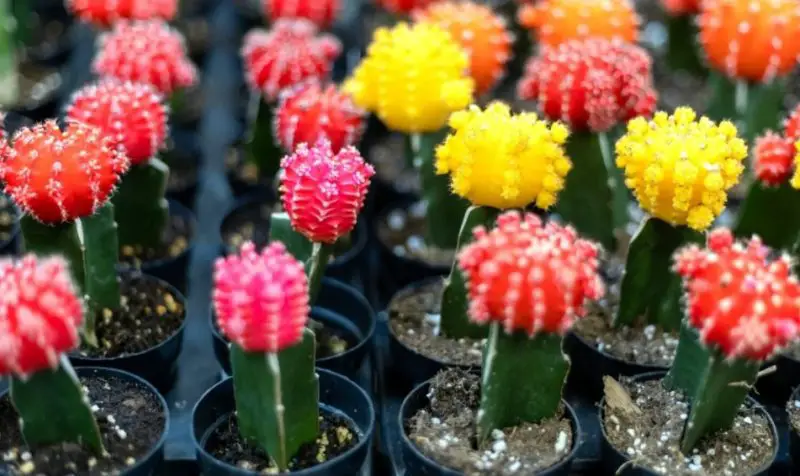
The Moon Cactus (Gymnocalycium mihanovichii) is a strikingly colorful cactus often seen in bright shades of red, yellow, orange, or pink. It lacks chlorophyll, which gives it its unique color, but also means it cannot produce its own food through photosynthesis. As a result, it is grafted onto a green cactus rootstock, usually a Hylocereus species, for survival. Its small size and vibrant appearance make it a popular houseplant.
Moon cacti prefer bright, indirect light and well-draining soil. They require minimal watering, as excessive moisture can cause root rot. Due to their delicate nature, they thrive best indoors where temperature and humidity are controlled. Although they produce small flowers under the right conditions, their primary appeal lies in their striking, colorful appearance rather than their blooms.
Old Man Cactus
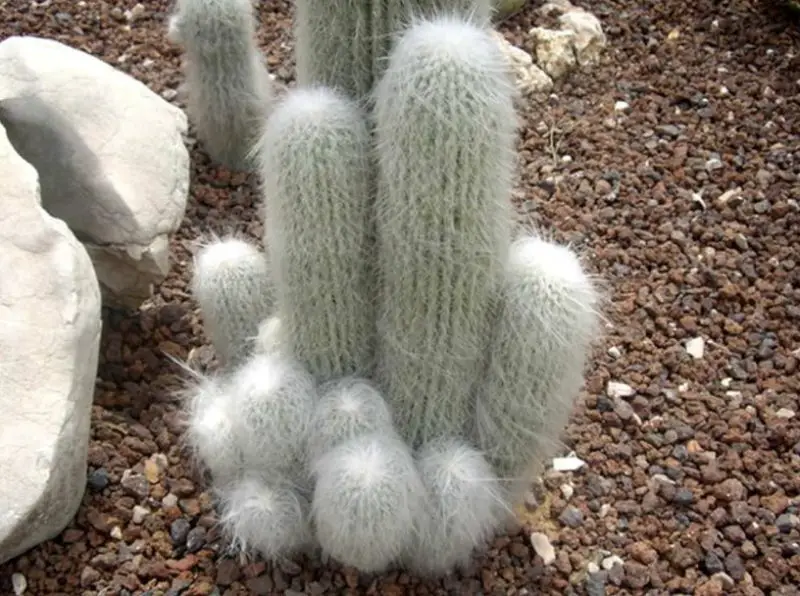
The Old Man Cactus (Cephalocereus senilis) is easily recognized by its long, white, hair-like spines that resemble an old man’s beard. This columnar cactus can grow up to 20 feet tall in its native habitat in Mexico. The white “hair” serves as protection, helping to reflect harsh sunlight and reduce water loss. Despite its fuzzy appearance, it has sharp spines hidden beneath its woolly exterior.
Thriving in arid, sunny environments, the Old Man Cactus prefers well-draining soil and minimal watering. It grows slowly but can live for decades with proper care. While it rarely flowers indoors, mature outdoor specimens may produce large, pinkish-white nocturnal blooms. This cactus is a popular choice for collectors due to its unique appearance and low-maintenance care requirements.
Old Lady Cactus
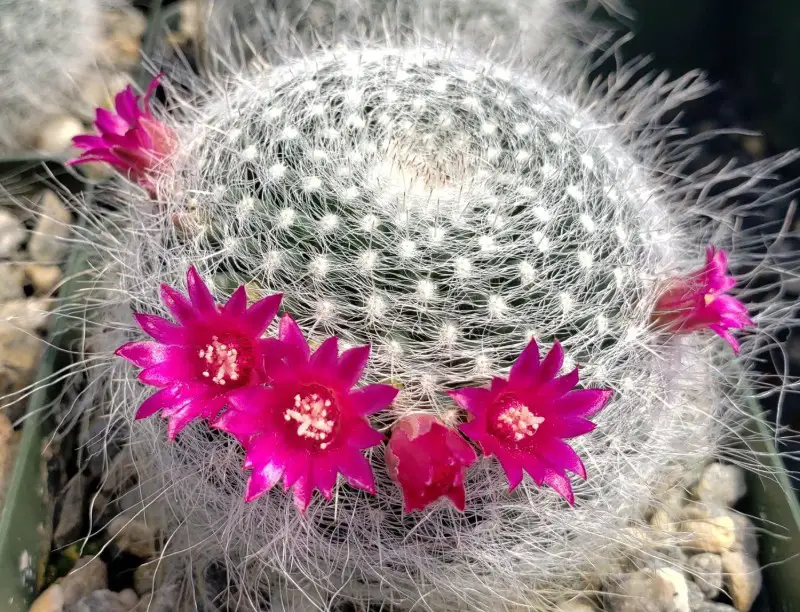
The Old Lady Cactus (Mammillaria hahniana) is a small, round cactus covered in dense white spines that give it a soft, fluffy appearance. This species forms clumps over time and can grow up to 10 inches tall. In spring and summer, it produces a ring of bright pink or purple flowers around the top of its body, resembling a floral crown.
Native to Mexico, the Old Lady Cactus thrives in full sun and well-draining soil. It is drought-tolerant and requires minimal watering, making it a great choice for rock gardens and indoor collections. Despite its soft look, its spines can be sharp, so handling should be done with care. With proper conditions, it can bloom annually, adding a charming touch to any succulent arrangement.
San Pedro Cactus

The San Pedro Cactus (Echinopsis pachanoi) is a fast-growing columnar cactus native to the Andes Mountains of South America. It features dark green, ribbed stems with small, evenly spaced spines and can grow up to 20 feet tall. This species is well-known for its medicinal and traditional uses, as well as its ability to thrive in various environments.
Adaptable to both dry and temperate climates, the San Pedro Cactus prefers full sun and well-draining soil. It requires occasional watering during the growing season but should be kept dry in winter to prevent rot. Under the right conditions, it produces large, fragrant white flowers that bloom at night. Its rapid growth rate makes it a favorite among gardeners looking to cultivate tall, striking cacti.
Fairy Castle Cactus
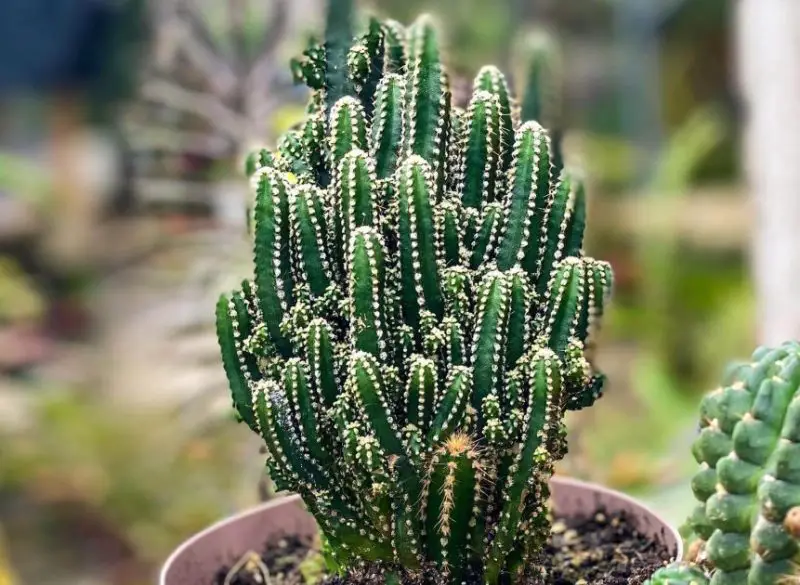
The Fairy Castle Cactus (Acanthocereus tetragonus) is a whimsical, branching cactus that forms spires resembling a miniature castle. Its deep green stems grow in a clustered pattern, with each “tower” covered in small white spines. This slow-growing cactus can reach up to six feet tall over time, making it an eye-catching addition to succulent gardens.
This species thrives in bright, indirect light and well-draining soil. It requires minimal watering and is highly drought-tolerant. While it rarely blooms indoors, mature specimens can produce large, white flowers at night. Its unique structure and easy care make it a popular choice for beginner gardeners and collectors alike.
Hedgehog Cactus

The Hedgehog Cactus (Echinocereus spp.) is a small, spiny cactus known for its vibrant, trumpet-shaped flowers that range in color from pink to red and purple. Its cylindrical stems grow in clusters, resembling a hedgehog’s spiny body. Many species within this genus produce edible fruit, similar to a small, sweet berry.
Native to North and Central America, the Hedgehog Cactus thrives in dry, rocky habitats with plenty of sunlight. It is highly drought-tolerant and prefers sandy, well-draining soil. This cactus is a favorite among gardeners due to its striking flowers, which bloom in spring and attract pollinators such as bees and hummingbirds. With proper care, it can be a resilient and visually stunning addition to any desert landscape.
Organ Pipe Cactus

The Organ Pipe Cactus (Stenocereus thurberi) is a tall, multi-stemmed cactus named for its resemblance to the pipes of a church organ. Its green, ribbed stems grow in clusters, reaching up to 25 feet tall. This slow-growing cactus is primarily found in the Sonoran Desert, where it thrives in rocky, well-draining soils. At night, it produces large, white, fragrant flowers that attract nocturnal pollinators like bats.
Adapted to extreme desert conditions, the Organ Pipe Cactus requires full sun and infrequent watering. It stores water in its thick stems to survive long periods of drought. Although it grows best in warm climates, it can tolerate brief cold spells. Its edible fruit, similar to a sweet berry, is enjoyed by both wildlife and humans.
Queen of the Night Cactus
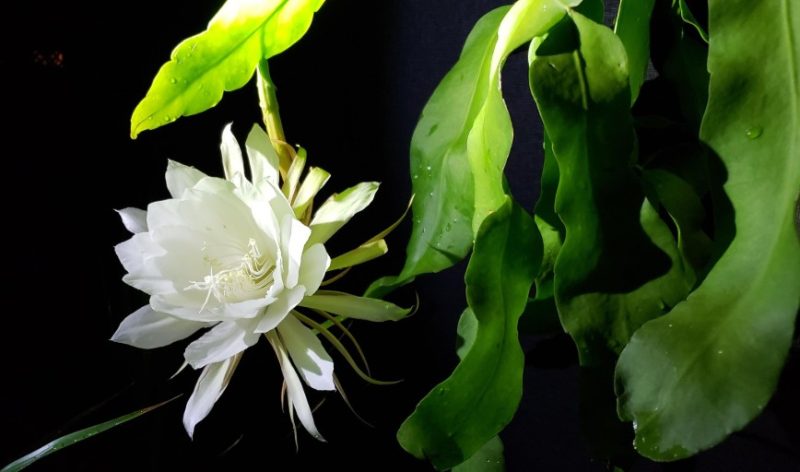
The Queen of the Night Cactus (Epiphyllum oxypetalum) is a stunning night-blooming cactus known for its large, white, highly fragrant flowers. This epiphytic species grows in tropical forests, where it climbs trees and absorbs moisture from the air. Its flat, leaf-like stems grow long and sprawling, often trailing over the edges of pots when cultivated indoors.
This cactus requires bright, indirect light and well-draining soil. It prefers warm, humid conditions and should be watered regularly but not excessively. Its flowers bloom only for a single night, making their appearance a rare and spectacular event. With proper care, it can thrive as a houseplant, adding beauty and elegance to any collection.
Peanut Cactus
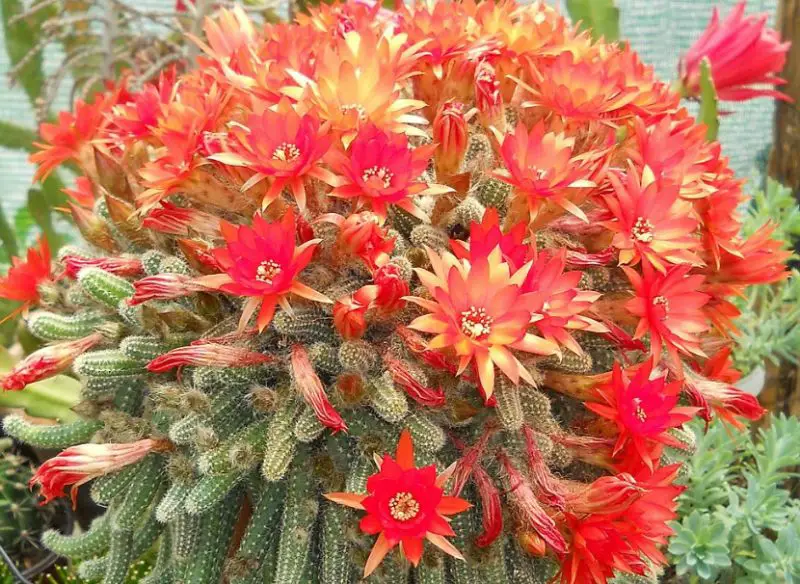
The Peanut Cactus (Echinopsis chamaecereus) is a low-growing, clumping cactus with slender, finger-like stems covered in soft, white spines. Its compact growth habit makes it a popular choice for container gardens. In late spring and summer, it produces vibrant orange or red flowers that contrast beautifully with its green stems.
Native to Argentina, the Peanut Cactus thrives in well-draining soil and bright sunlight. It is highly drought-tolerant and requires minimal watering. This cactus is easy to propagate, as its small offsets can be easily removed and replanted. Its fast growth and colorful blooms make it a favorite among succulent enthusiasts.
Rat Tail Cactus
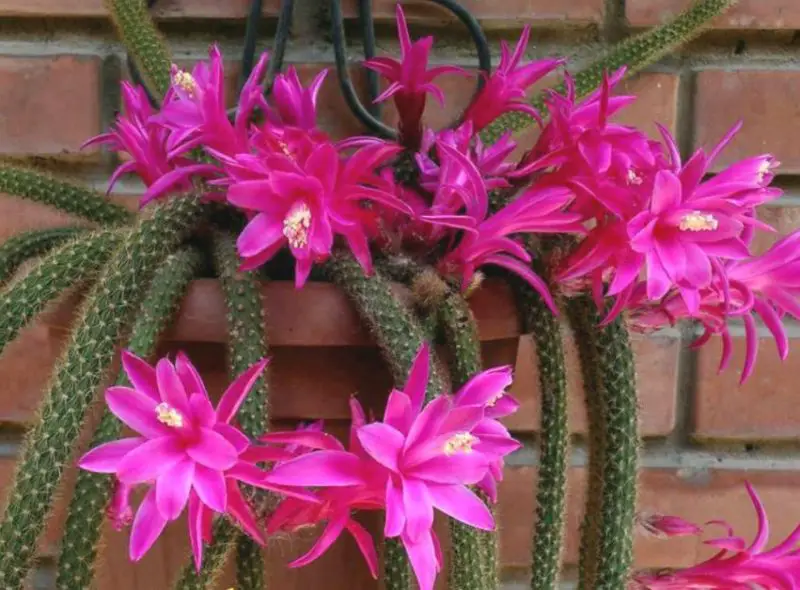
The Rat Tail Cactus (Disocactus flagelliformis) is a trailing cactus with long, slender stems that can grow several feet in length. Its stems are covered in fine, reddish spines that give it a fuzzy appearance. In spring and summer, it produces bright pink or red tubular flowers, adding a striking contrast to its trailing growth habit.
This species thrives in hanging baskets, where its stems can cascade down beautifully. It prefers bright, indirect light and well-draining soil. While drought-tolerant, it benefits from occasional watering during the growing season. Given proper care, it is a resilient and visually appealing cactus for indoor or outdoor cultivation.
Silver Torch Cactus
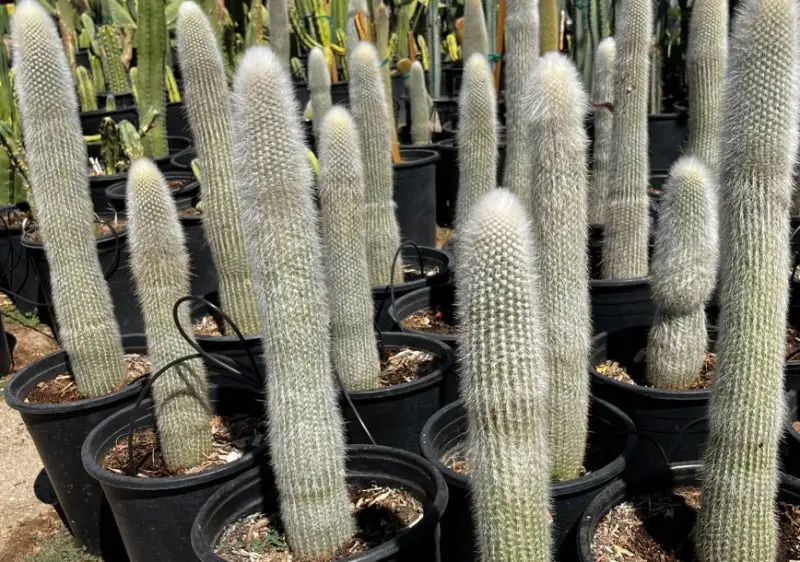
The Silver Torch Cactus (Cleistocactus strausii) is a tall, columnar cactus known for its dense covering of silvery-white spines. It can grow up to 10 feet tall, with multiple stems forming over time. Despite its spiny appearance, it produces vibrant red, tubular flowers that emerge from the sides of its stems, often attracting hummingbirds.
Native to the high-altitude regions of Bolivia and Argentina, this cactus thrives in cooler, arid conditions with full sun exposure. It requires well-draining soil and minimal watering to prevent rot. Its striking silver appearance and vertical growth make it a favorite in rock gardens and xeriscaping projects.
Peruvian Apple Cactus
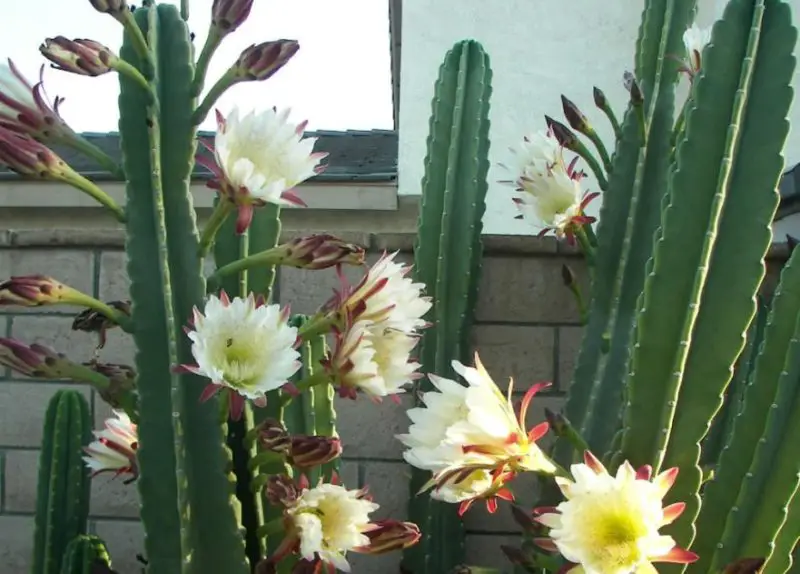
The Peruvian Apple Cactus (Cereus repandus) is a fast-growing, tree-like cactus with tall, ribbed, blue-green stems. It can reach up to 30 feet tall and is known for its large, white, night-blooming flowers. These flowers develop into edible, sweet-tasting fruits known as “Peruvian apples,” which are enjoyed by both people and wildlife.
This cactus thrives in warm, dry climates and prefers full sun and well-draining soil. It requires occasional watering during the growing season but should be kept dry in winter. Due to its rapid growth and fruit production, it is often cultivated as both an ornamental and a functional plant in desert landscapes.
Blue Myrtle Cactus
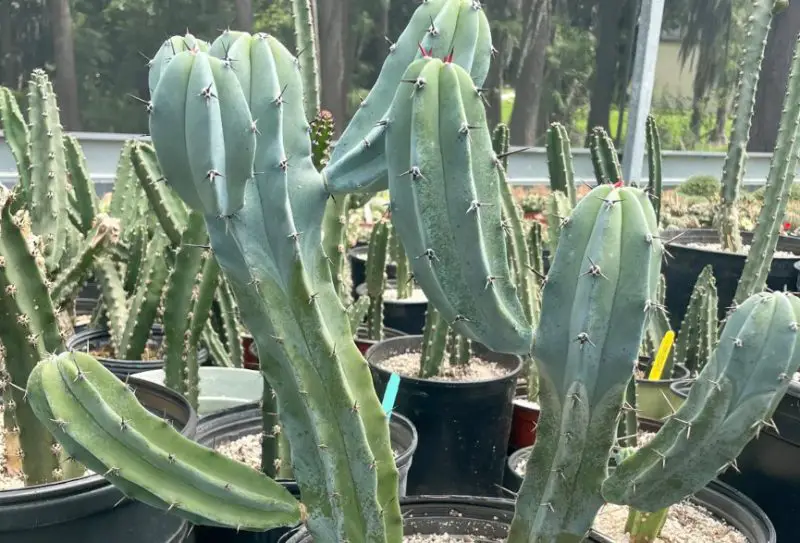
The Blue Myrtle Cactus (Myrtillocactus geometrizans) is a fast-growing, tree-like cactus with distinctive blue-green stems. It can reach up to 15 feet tall, developing multiple branching arms that give it an attractive, sculptural appearance. During the spring, it produces small, creamy-white flowers, which later develop into edible, dark purple berries known as “garambullo.”
Native to Mexico, this cactus thrives in full sun and well-draining soil. It is drought-tolerant but benefits from occasional watering during the growing season. Its striking blue hue, rapid growth, and ability to produce edible fruit make it a favorite among succulent collectors and landscape designers.
Teddy Bear Cholla
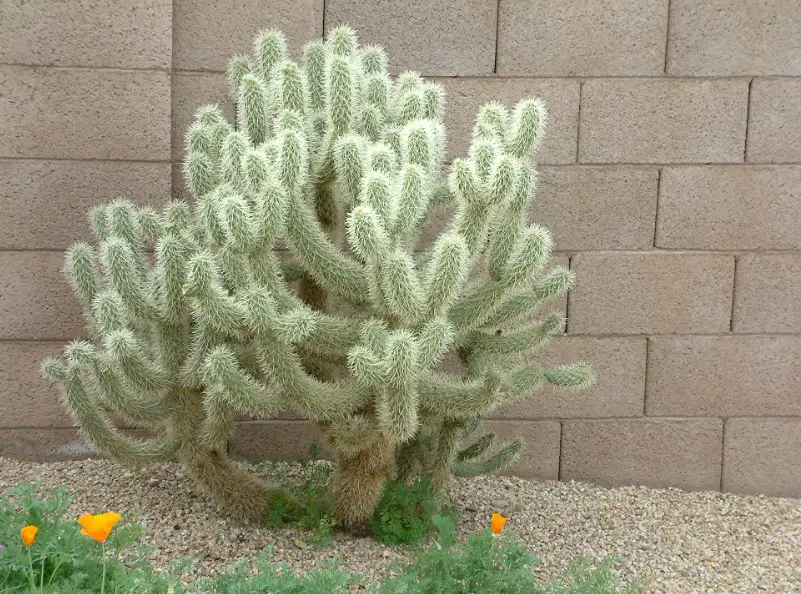
The Teddy Bear Cholla (Cylindropuntia bigelovii) is a uniquely spiny cactus known for its dense covering of golden, barbed spines that give it a fuzzy, teddy bear-like appearance. However, despite its inviting look, its spines are incredibly sharp and detach easily upon contact. This cactus grows in dense clusters, with individual stems reaching up to 5 feet tall.
Found in the deserts of the southwestern United States and Mexico, the Teddy Bear Cholla thrives in full sun and dry, rocky soil. It is highly drought-tolerant and requires minimal watering. In late spring, it produces greenish-yellow flowers, followed by small, spine-covered fruits. Due to its formidable spines, this cactus is best admired from a safe distance.
Barrel Cactus
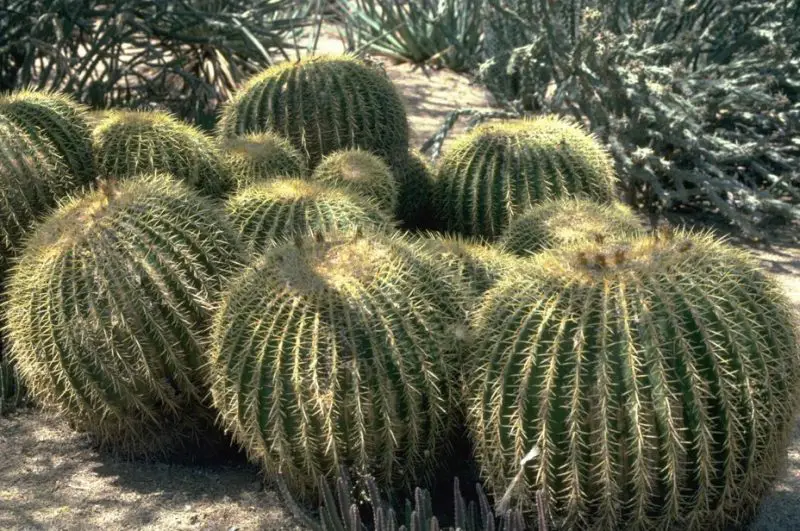
The Barrel Cactus (Ferocactus spp.) is a round, ribbed cactus that can grow up to 3 feet tall and wide. It is covered in long, curved spines, which help protect it from herbivores. This slow-growing cactus is well-known for its ability to store water in its thick, fleshy body, allowing it to survive long periods of drought.
Native to arid regions of North and Central America, the Barrel Cactus thrives in full sun and sandy, well-draining soil. In late summer, it produces bright yellow, orange, or red flowers, which bloom in a circular pattern at the top of the plant. Its ability to survive in harsh desert environments makes it a staple in xeriscaping and rock gardens.
Brain Cactus
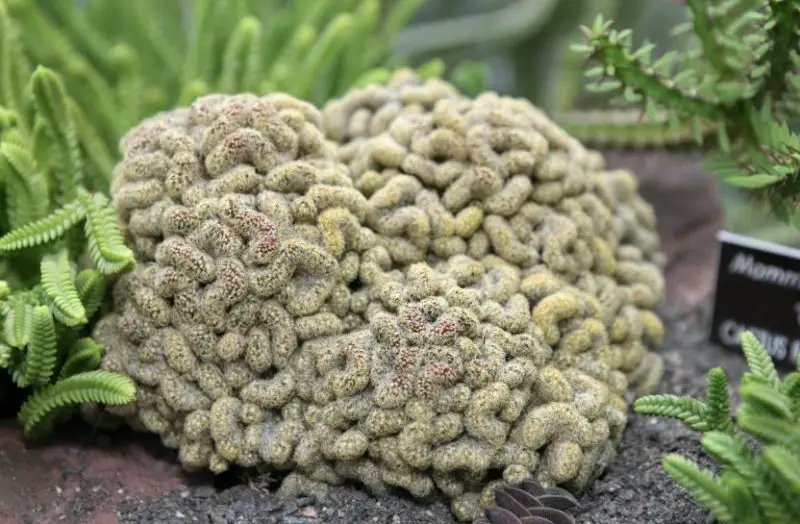
The Brain Cactus (Mammillaria elongata ‘Cristata’) is a fascinating, crested variety of the Golden Star Cactus. Its unique, twisted growth pattern resembles the folds of a brain, making it a highly sought-after specimen among cactus collectors. Its green, wavy stems are covered in small, golden spines, adding to its unusual appearance.
This cactus thrives in bright, indirect light and well-draining soil. It is drought-tolerant and should be watered sparingly to prevent rot. While it rarely blooms, it can occasionally produce small, pink flowers along the ridges of its folds. Its compact size and intriguing form make it a perfect choice for small indoor gardens and succulent arrangements.
Fishbone Cactus
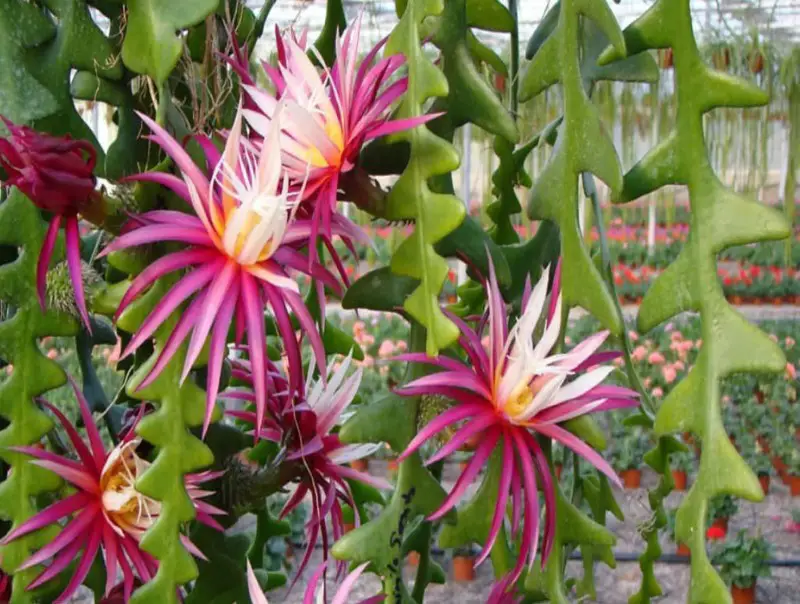
The Fishbone Cactus (Disocactus anguliger), also known as the Zig-Zag Cactus, is an epiphytic species with flat, wavy stems that resemble a fish skeleton. Unlike most cacti, it thrives in tropical environments and prefers higher humidity levels. This unique plant is popular for its ornamental appeal and ability to adapt well to indoor settings.
Native to the rainforests of Mexico, the Fishbone Cactus requires bright, indirect light and well-draining soil. It should be watered regularly but allowed to dry out slightly between waterings. In late summer or early fall, it can produce large, fragrant white flowers that bloom at night, adding to its exotic charm.
Totem Pole Cactus
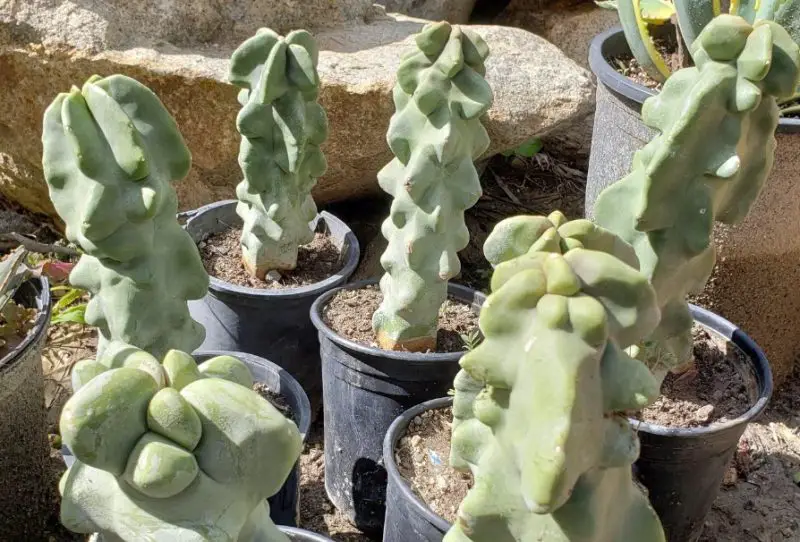
The Totem Pole Cactus (Pachycereus schottii var. monstrosus) is a spineless, columnar cactus with a smooth, bumpy surface. Its unusual appearance, with knobby, irregular growth patterns, makes it a striking addition to succulent gardens. It can grow up to 12 feet tall, forming tall, twisting columns over time.
This slow-growing cactus thrives in full sun and well-draining soil. It requires minimal watering and is highly drought-resistant. Unlike many cacti, it lacks sharp spines, making it a great choice for landscapes where people and pets may come into contact with it. Its sculptural beauty and ease of care make it a favorite for desert gardens and collectors.
Bolivian Torch Cactus
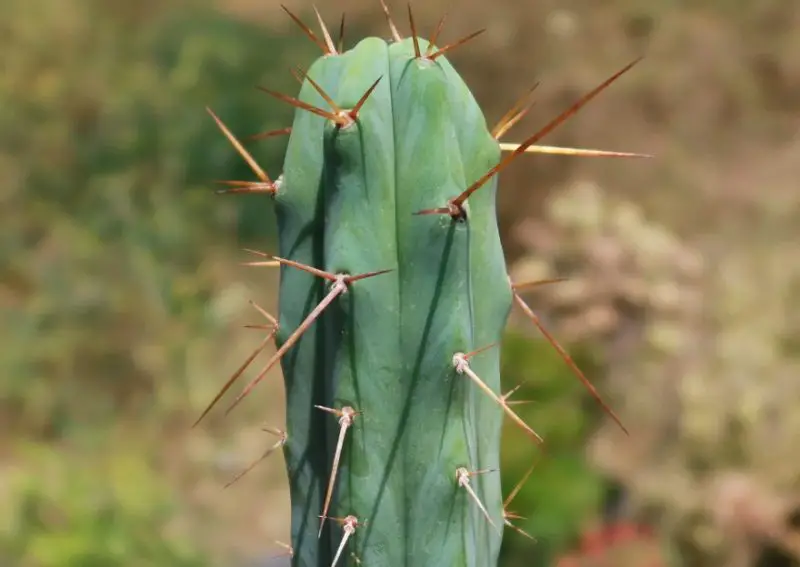
The Bolivian Torch Cactus (Echinopsis lageniformis), also known as Trichocereus bridgesii, is a fast-growing, columnar cactus native to Bolivia. It has tall, bluish-green stems with pronounced ribs lined with clusters of sharp, golden spines. This species can grow up to 10 feet tall, making it a striking addition to any arid landscape.
Known for its rapid growth and resilience, the Bolivian Torch Cactus thrives in full sun and well-draining soil. It requires minimal watering and is highly drought-tolerant. In summer, it produces large, white, night-blooming flowers that attract nocturnal pollinators. Its sculptural form and low maintenance needs make it popular among cactus collectors.
Bishop’s Cap Cactus
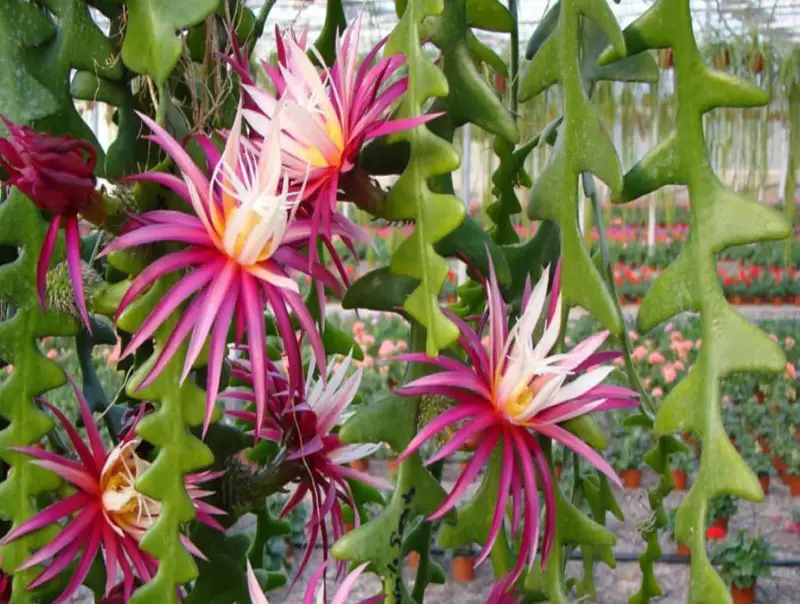
The Bishop’s Cap Cactus (Astrophytum myriostigma) is a distinctive, star-shaped cactus with smooth, green skin covered in tiny white dots. It typically has five ribs, giving it a symmetrical, geometric appearance, though some specimens may develop additional ribs as they mature. This spineless species remains relatively small, rarely exceeding 12 inches in height.
Native to Mexico, this cactus thrives in bright, indirect light and well-draining soil. It requires infrequent watering, as it is highly susceptible to rot. During the spring and summer, it produces bright yellow flowers at its crown, adding a splash of color to its otherwise muted tones. Its unique shape and low-maintenance care make it a favorite among collectors.
Jumping Cholla Cactus
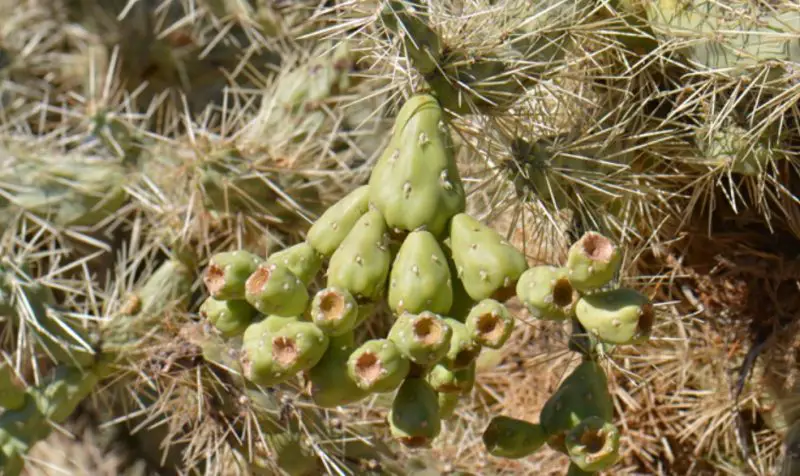
The Jumping Cholla Cactus (Cylindropuntia fulgida) is infamous for its spiny, segmented stems that easily detach upon contact. Its dense covering of sharp, barbed spines gives it a silvery appearance, particularly in sunlight. This cactus grows in shrub-like formations, reaching up to 10 feet tall, and often forms large, impenetrable thickets.
Found in the deserts of the southwestern United States and Mexico, the Jumping Cholla thrives in full sun and arid conditions. In summer, it produces small, pinkish-white flowers, followed by chain-like clusters of fruit. While its spiny nature makes it hazardous to handle, it plays a vital role in desert ecosystems, providing shelter for various wildlife species.
Golden Torch Cactus
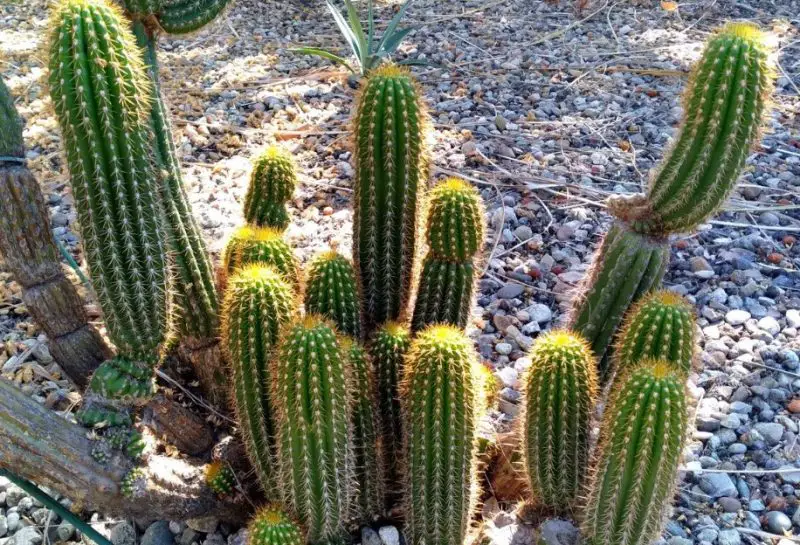
The Golden Torch Cactus (Echinopsis spachiana) is a tall, columnar species with a bright green body lined with rows of short, golden-yellow spines. It can grow up to 7 feet tall and produces large, showy white flowers that bloom at night. This species is prized for its ornamental appeal and ability to thrive in various conditions.
Native to South America, the Golden Torch Cactus requires full sun and well-draining soil. It is highly drought-resistant and needs only occasional watering. Due to its rapid growth and striking flowers, it is often used in xeriscaping and rock gardens. Its easy care and vertical growth make it a popular choice for both indoor and outdoor spaces.
Mistletoe Cactus
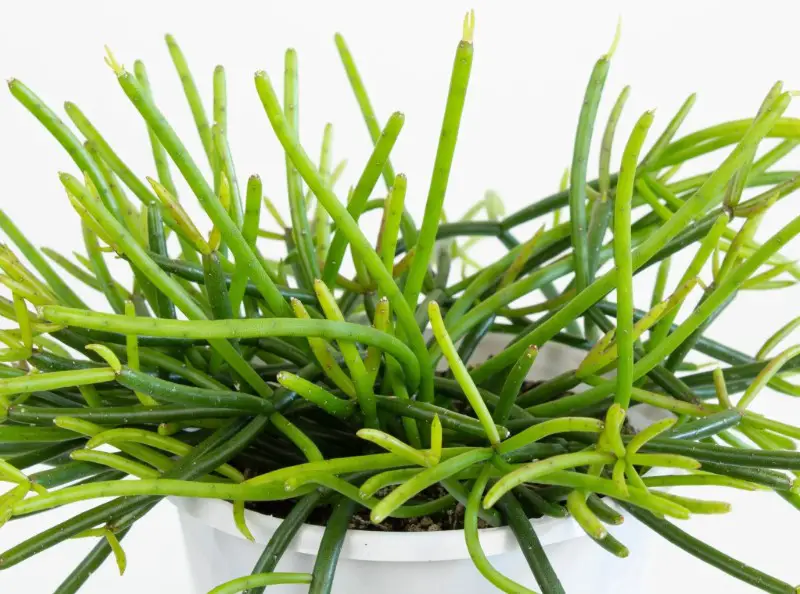
The Mistletoe Cactus (Rhipsalis baccifera) is an epiphytic, trailing cactus that grows in rainforests rather than arid deserts. Unlike most cacti, it has long, thin, green stems that cascade downward, making it ideal for hanging baskets. It produces tiny, white or pale green flowers followed by small, berry-like fruits.
This tropical cactus thrives in bright, indirect light and prefers higher humidity levels. It requires well-draining soil and regular watering to keep its stems from drying out. Unlike its spiny relatives, the Mistletoe Cactus is completely spineless, making it a safe and decorative choice for indoor spaces. Its lush, trailing growth and unique habitat set it apart from typical desert cacti.
Cane Cholla Cactus
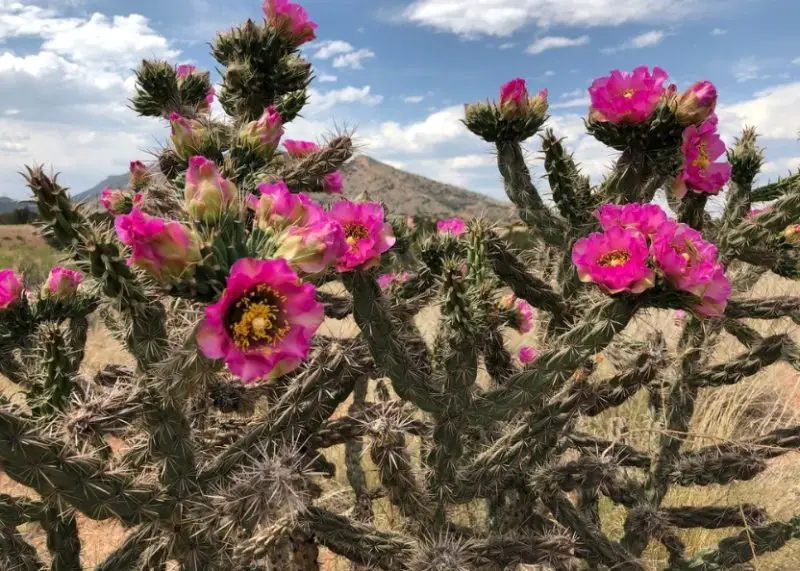
The Cane Cholla Cactus (Cylindropuntia imbricata) is a tree-like cactus with thick, cylindrical stems covered in dense clusters of sharp spines. It can grow up to 8 feet tall and develops a woody trunk as it matures, giving it a shrub-like appearance. In spring and summer, it produces vibrant magenta flowers that contrast beautifully against its green stems.
Native to the southwestern United States and Mexico, the Cane Cholla thrives in full sun and well-draining soil. It is extremely drought-tolerant and can withstand harsh desert conditions. While its spiny stems deter most animals, birds often use its branches as nesting sites, taking advantage of its protective structure. Its bold presence and resilience make it a striking addition to desert landscapes.
Texas Barrel Cactus
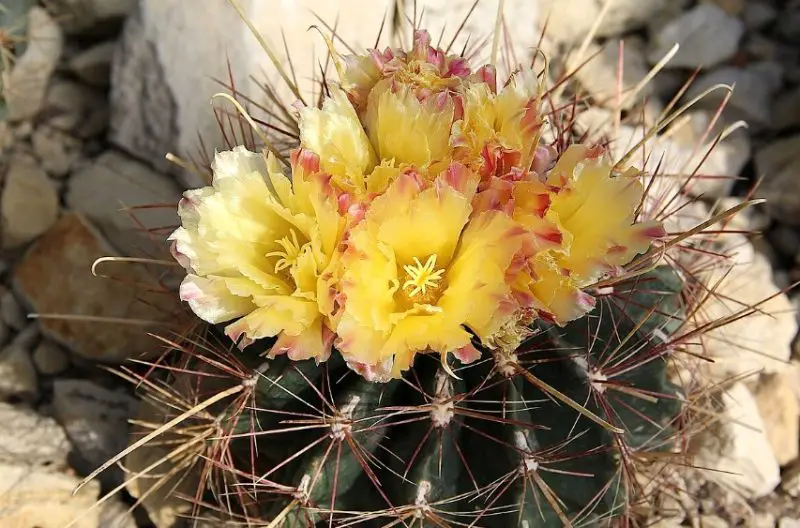
The Texas Barrel Cactus (Ferocactus hamatacanthus), also known as the “Turk’s Head Cactus,” is a stout, ribbed cactus with long, hooked spines that give it a striking appearance. It can grow up to 2 feet tall and 1.5 feet wide, forming a nearly spherical shape. In late summer, it produces large, showy yellow flowers with reddish centers, followed by small, fleshy fruits.
Native to Texas, New Mexico, and northern Mexico, this cactus thrives in full sun and well-draining soil. It is highly drought-tolerant and requires minimal watering. Its resilience and striking form make it a favorite for desert landscapes and rock gardens, where it adds both texture and color.
Engelmann’s Prickly Pear
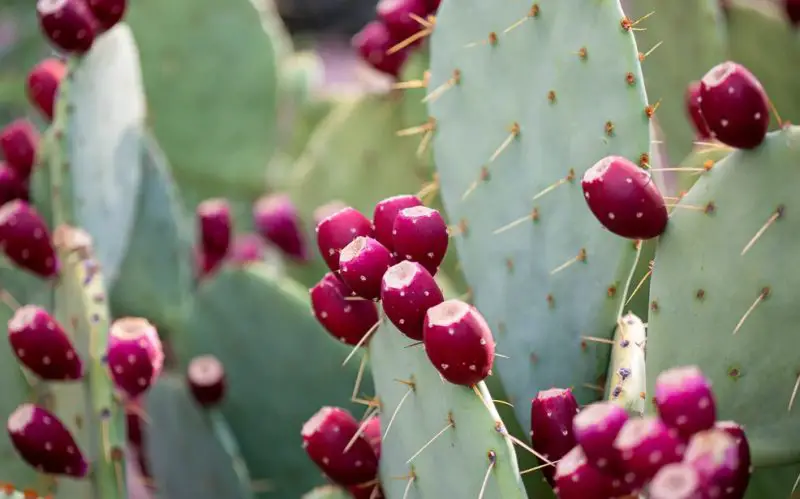
Engelmann’s Prickly Pear (Opuntia engelmannii) is a sprawling, shrubby cactus with large, flat, green pads covered in clusters of spines and tiny, hair-like glochids. It can grow up to 5 feet tall and spread widely, forming dense thickets. In spring and early summer, it produces bright yellow flowers that give way to edible, reddish-purple fruits known as “tunas.”
Commonly found in the southwestern United States and northern Mexico, this hardy cactus thrives in full sun and dry, rocky soils. It is highly drought-resistant and can survive with minimal water. Its fruit is an important food source for wildlife, while its pads provide shelter for desert creatures. Due to its adaptability and striking blooms, it is widely used in xeriscaping.
Snowball Cactus
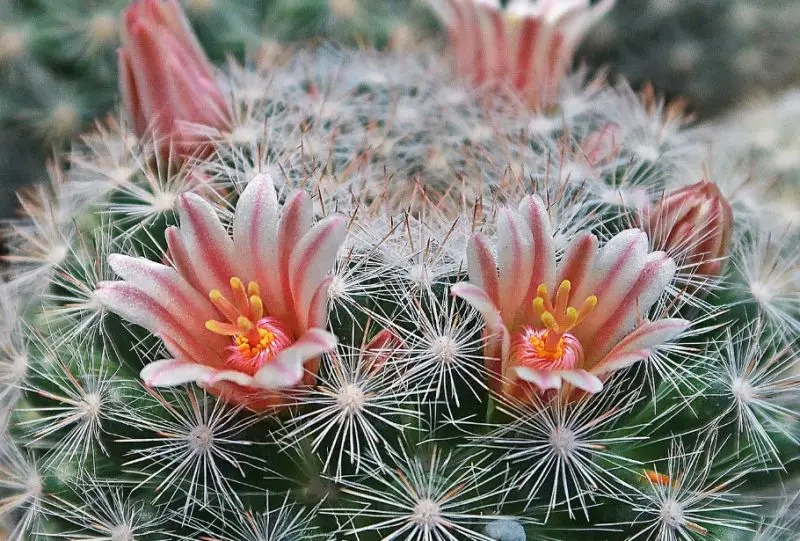
The Snowball Cactus (Mammillaria candida) is a small, globular cactus known for its dense covering of white spines, giving it a fuzzy, snowball-like appearance. It usually grows in clusters, with individual stems reaching about 4 inches tall. During the spring and summer, it produces small, pink or purple flowers that form a crown around the top of each stem.
Native to Mexico, this cactus thrives in bright, indirect light and well-draining soil. It requires infrequent watering and is susceptible to overwatering, which can lead to rot. Its compact size, unique texture, and charming flowers make it a popular choice for indoor succulent collections and rock gardens.
Turk’s Cap Cactus
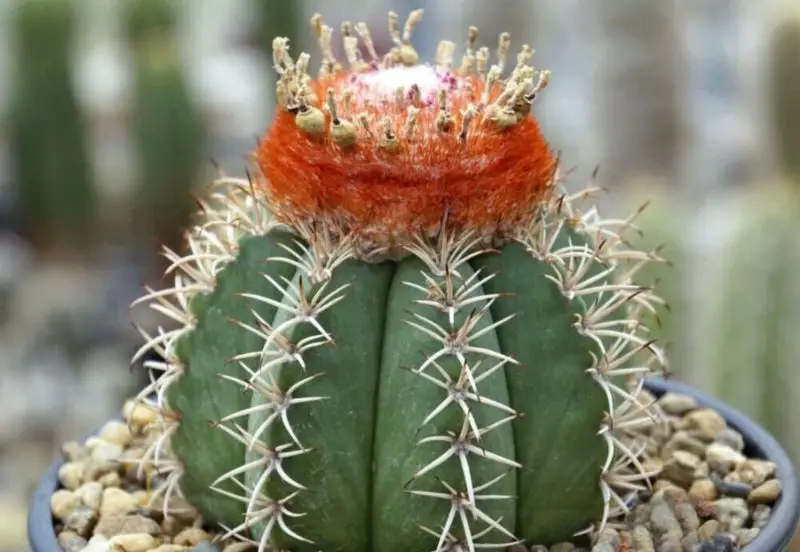
The Turk’s Cap Cactus (Melocactus matanzanus) is a distinctive species known for its rounded, ribbed body topped with a woolly, red cephalium resembling a fez or turban. As the plant matures, the cephalium expands, eventually producing small, bright pink flowers that emerge from the top.
Native to the Caribbean and parts of Central and South America, this cactus prefers warm temperatures, bright light, and well-draining soil. It requires consistent but light watering, as it is prone to root rot. Its unusual growth habit and vibrant cephalium make it a fascinating addition to any cactus collection.
Claret Cup Cactus
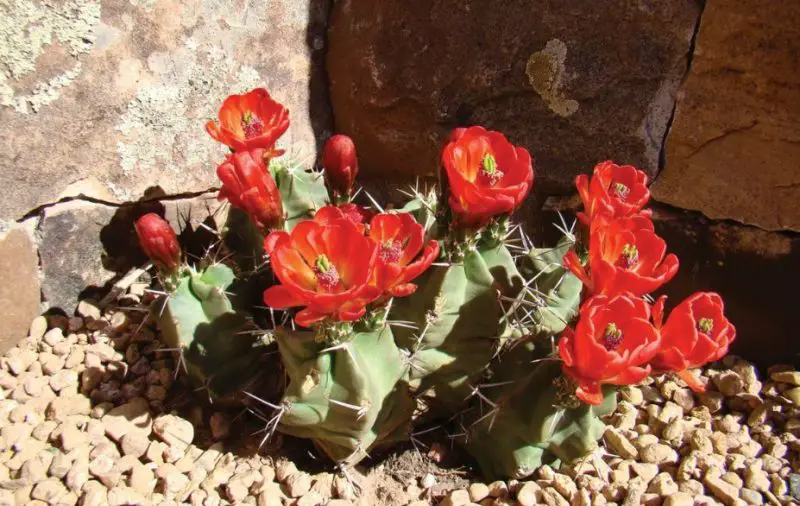
The Claret Cup Cactus (Echinocereus triglochidiatus), also known as the “Hedgehog Cactus,” is a low-growing species with cylindrical stems covered in clusters of sharp spines. It forms dense clumps that can spread up to 3 feet wide. In spring, it produces stunning, cup-shaped red flowers with bright green centers, which attract hummingbirds.
Found in the southwestern United States and northern Mexico, this cactus thrives in full sun and well-draining, rocky soils. It is highly drought-tolerant and requires little maintenance. Its brilliant blooms and compact growth make it a favorite for desert gardens, rock landscapes, and wildlife-friendly plantings.
Creeping Devil Cactus
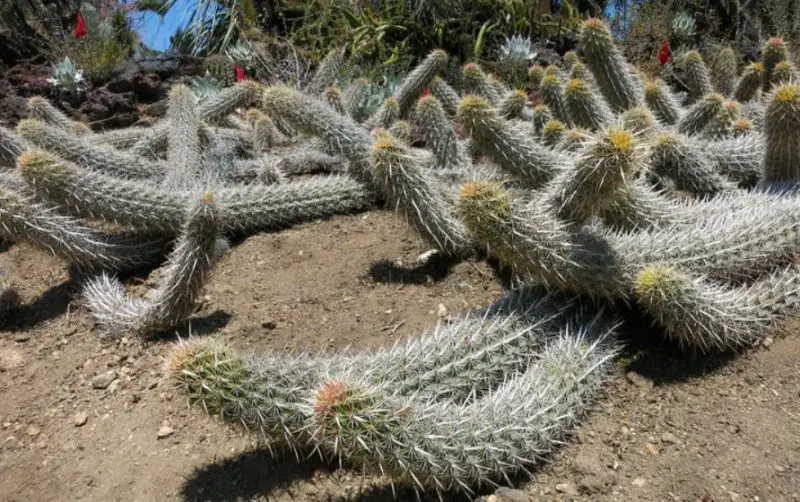
The Creeping Devil Cactus (Stenocereus eruca) is one of the most unusual cacti, known for its horizontal, crawling growth habit. Instead of growing upright, this cactus lies along the ground and slowly moves over time by rooting at one end while the older portion dies off. Its long, ribbed stems are covered in sharp spines, deterring herbivores.
Native to the sandy deserts of Baja California, Mexico, the Creeping Devil thrives in full sun and extremely dry conditions. It requires minimal watering and is highly adapted to arid environments. Due to its rare growth pattern and eerie name, it is a fascinating species for collectors and botanical enthusiasts.
Candelabra Cactus
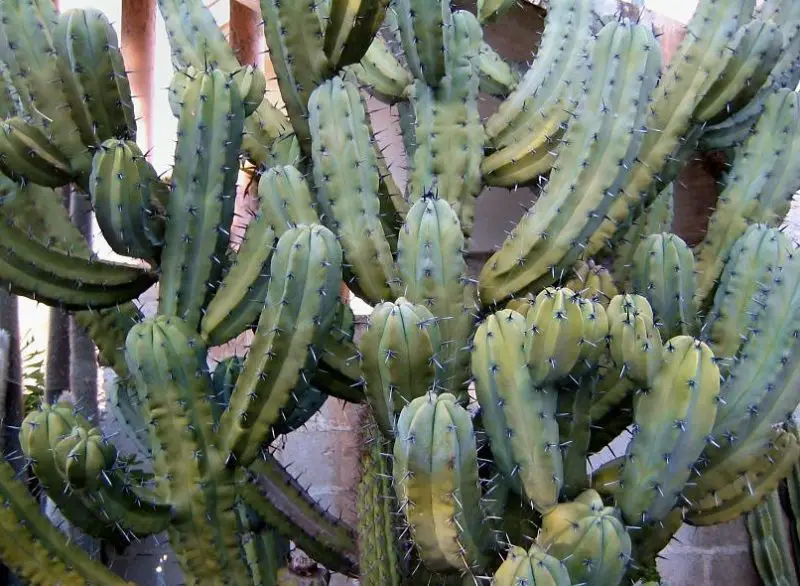
The Candelabra Cactus (Myrtillocactus geometrizans) is a fast-growing, tree-like cactus with multiple upward-reaching branches that resemble a candelabrum. It has smooth, blue-green skin and pronounced ribs lined with small clusters of spines. This species can grow up to 15 feet tall, making it a striking focal point in arid landscapes.
Native to Mexico, the Candelabra Cactus thrives in full sun and well-draining soil. It is highly drought-resistant and requires minimal watering. In spring, it produces small, greenish-white flowers followed by edible, dark purple fruits known as “garambullo.” Its rapid growth and architectural form make it a popular choice for gardens and landscapes.
Night Blooming Cereus

The Night Blooming Cereus (Epiphyllum oxypetalum) is a vining cactus known for its spectacular, fragrant white flowers that bloom only at night. These large, star-shaped flowers can reach up to 10 inches across and emit a strong, sweet scent to attract nocturnal pollinators. Its stems are flat, leaf-like, and grow in a sprawling manner.
This tropical cactus thrives in warm, humid conditions with bright, indirect light. It requires well-draining soil and moderate watering. Since its blooms are short-lived, often lasting just one night, witnessing its flowering is considered a rare and special event. It is commonly grown as an ornamental houseplant due to its unique flowering habit.
Pencil Cactus
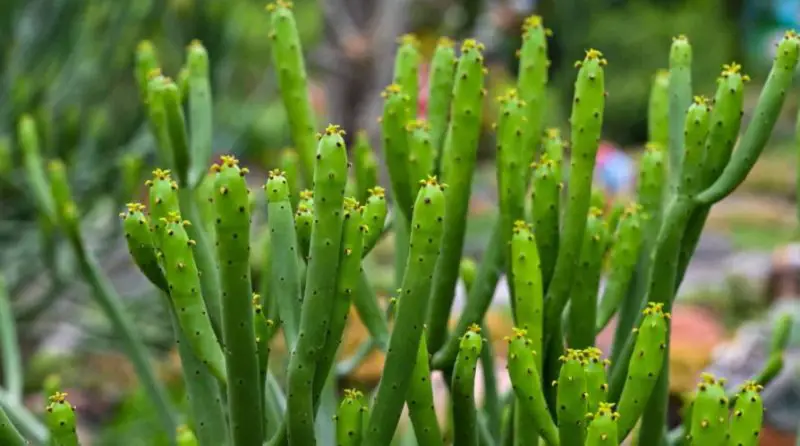
The Pencil Cactus (Euphorbia tirucalli), also known as the “Firestick Plant,” is a striking, branching succulent with thin, cylindrical, green stems that can turn bright red or orange under stress. It lacks traditional leaves and spines, giving it a distinct, minimalistic appearance. In its native habitat, it can grow up to 30 feet tall, but it remains much smaller when cultivated as a houseplant.
Native to Africa and India, the Pencil Cactus thrives in full sun and dry, well-draining soil. It is highly drought-tolerant and requires little maintenance. However, its milky sap is toxic and can cause skin irritation, making it important to handle with care. Its bold structure and unique coloration make it a favorite in modern landscaping and container gardening.
Bishop’s Hood Cactus

The Bishop’s Hood Cactus (Astrophytum ornatum) is a columnar species with a symmetrical, ribbed body covered in small, white speckles. It has prominent yellowish spines along its ribs, giving it a striking appearance. This cactus can grow up to 3 feet tall and develops a more elongated shape as it matures.
Native to Mexico, this cactus thrives in full sun and well-draining soil. It is drought-tolerant and requires minimal watering. During the warmer months, it produces bright yellow, daisy-like flowers at its crown. Its distinctive form and resilience make it a popular choice among cactus collectors.
White Bunny Ears Cactus
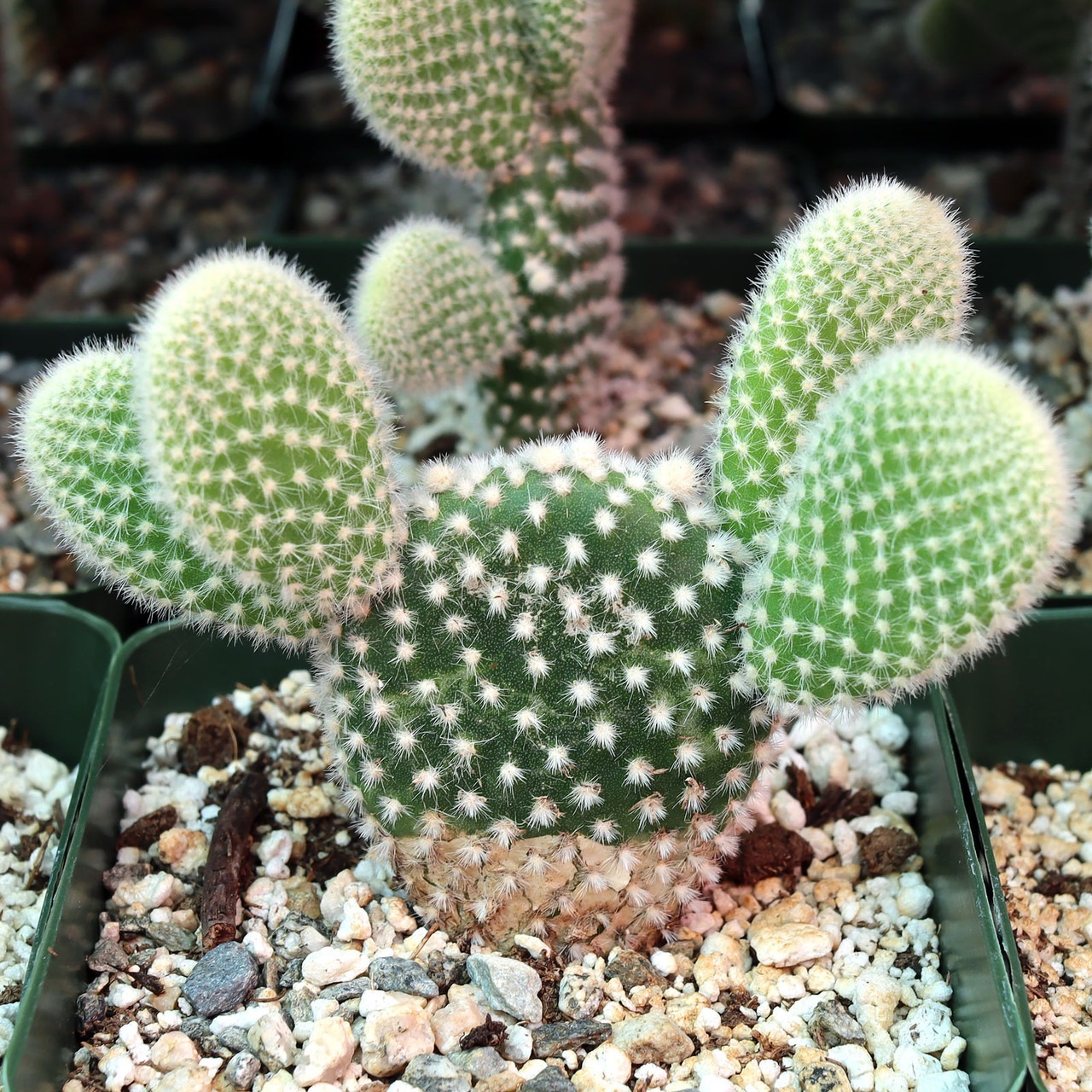
The White Bunny Ears Cactus (Opuntia microdasys albata) is a compact, pad-forming cactus covered in dense, white, fuzzy-looking glochids instead of traditional spines. Its pads resemble the ears of a rabbit, giving it a charming and whimsical appearance. It typically grows up to 2 feet tall and spreads outward over time.
Native to Mexico, this cactus thrives in full sun and dry, well-draining soil. Despite its soft appearance, its glochids can cause skin irritation, so handling with care is advised. It requires little water and is well-suited to both outdoor rock gardens and indoor container cultivation. Its unique look makes it a favorite among succulent enthusiasts.
Cholla Cactus
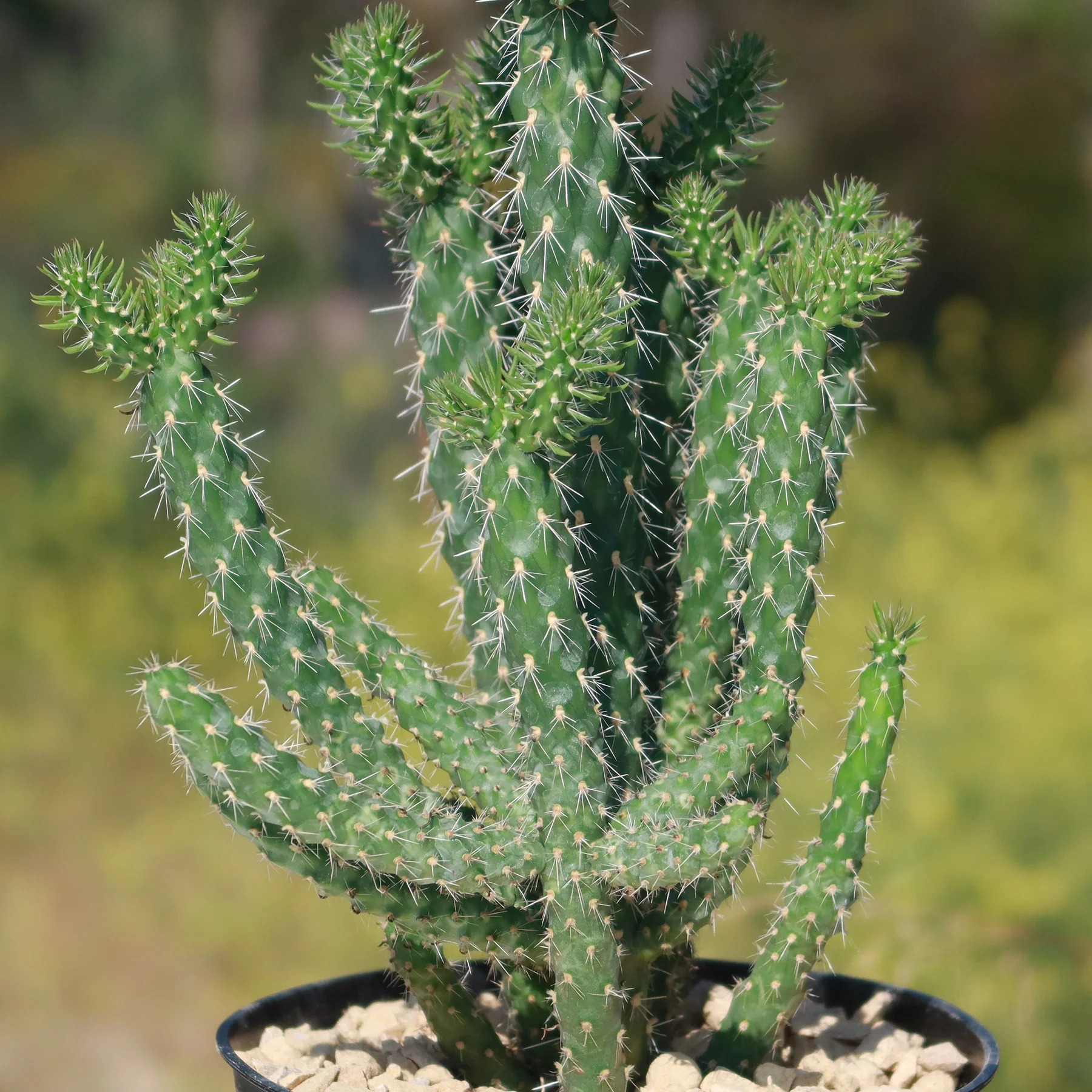
The Cholla Cactus (Cylindropuntia spp.) is a group of cacti known for their segmented, spiny stems that easily detach upon contact. These cacti vary in size and shape, with some growing as low shrubs and others reaching up to 10 feet tall. Their spines are covered in a papery sheath, giving them a golden or silvery glow in sunlight.
Native to the deserts of the southwestern United States and Mexico, Cholla Cacti thrive in full sun and dry, sandy soils. They produce colorful flowers in shades of yellow, pink, or red, followed by spiny, persistent fruit. While their sharp spines make them difficult to handle, they provide essential shelter for desert wildlife. Their striking appearance and resilience make them a common feature in arid landscapes.
Fishhook Cactus
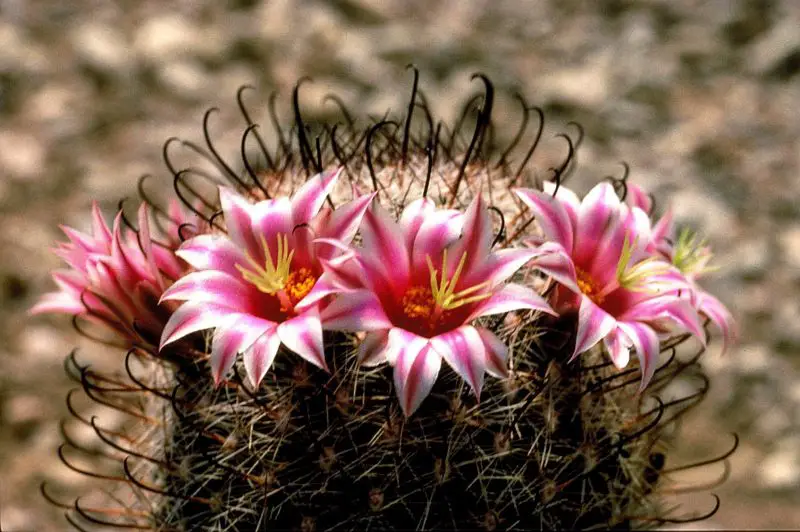
The Fishhook Cactus (Mammillaria spp.) is a small, round cactus named for its distinctive hooked spines, which curve like a fishhook. It typically grows in a solitary or clumping form, reaching up to 8 inches in height. During spring and summer, it produces bright pink or red flowers that form a ring around the top of the plant, adding to its visual appeal.
Native to the arid regions of the southwestern United States and Mexico, this hardy cactus thrives in rocky, well-draining soil with full sun exposure. Its hooked spines help deter herbivores, while its drought tolerance allows it to survive with minimal water. Its compact size and striking appearance make it a popular choice for rock gardens and potted collections.
Beavertail Cactus
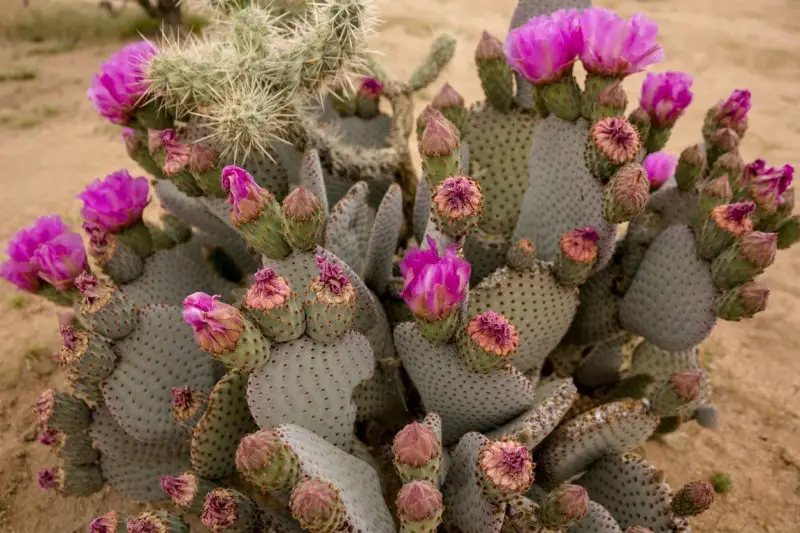
The Beavertail Cactus (Opuntia basilaris) is a low-growing, pad-forming species with smooth, blue-green pads that lack large spines but are covered in tiny, hair-like glochids. It gets its name from the shape of its pads, which resemble a beaver’s tail. In spring, it produces stunning magenta-pink flowers that contrast beautifully with its muted pads.
Native to the deserts of the southwestern United States, this cactus thrives in dry, well-draining soil and full sun. It is highly drought-tolerant and requires little maintenance. Its spineless nature makes it a safer choice for gardens, while its showy flowers attract pollinators, making it a valuable addition to xeriscapes.
Arizona Queen of the Night
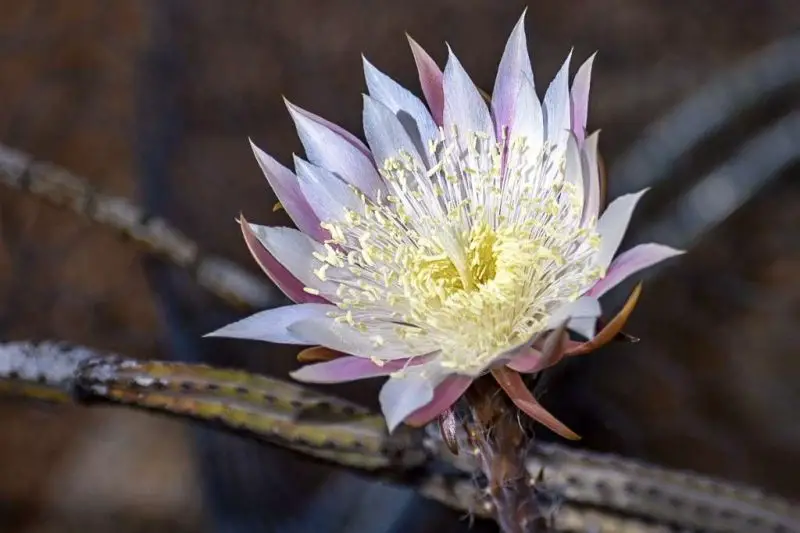
The Arizona Queen of the Night (Peniocereus greggii) is a rare, night-blooming cactus with long, thin, spindly stems that blend into surrounding vegetation. Its most remarkable feature is its large, fragrant white flowers, which bloom for a single night in summer before wilting by morning. These flowers attract moths and other nocturnal pollinators.
Native to the Sonoran Desert, this cactus thrives in rocky, well-draining soil with minimal water. Its stems are often camouflaged among shrubs, making it difficult to spot when not in bloom. Due to its elusive nature and short-lived blossoms, the Arizona Queen of the Night is considered one of the most enchanting desert plants.
Cardon Cactus
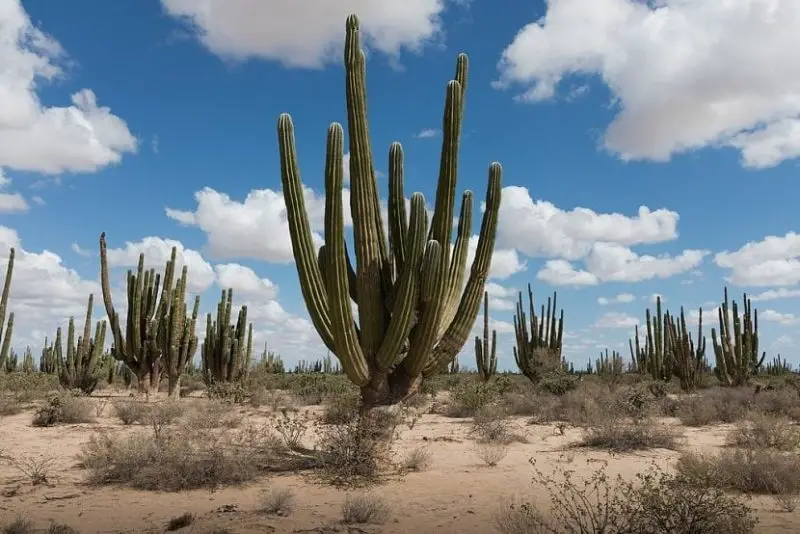
The Cardon Cactus (Pachycereus pringlei) is the tallest cactus species in the world, capable of reaching heights of over 60 feet. It has a thick, columnar trunk with multiple upward-growing arms, resembling a massive version of the saguaro cactus. Its surface is lined with vertical ribs and clusters of sharp spines, and it produces large white flowers that bloom at night.
Native to Mexico’s Baja California Peninsula, this slow-growing giant thrives in dry, rocky environments with full sun exposure. It is extremely drought-tolerant and can store large amounts of water in its trunk. Due to its impressive size and longevity, the Cardon Cactus is a key species in desert ecosystems, providing habitat and food for various wildlife.
Cochineal Nopal Cactus
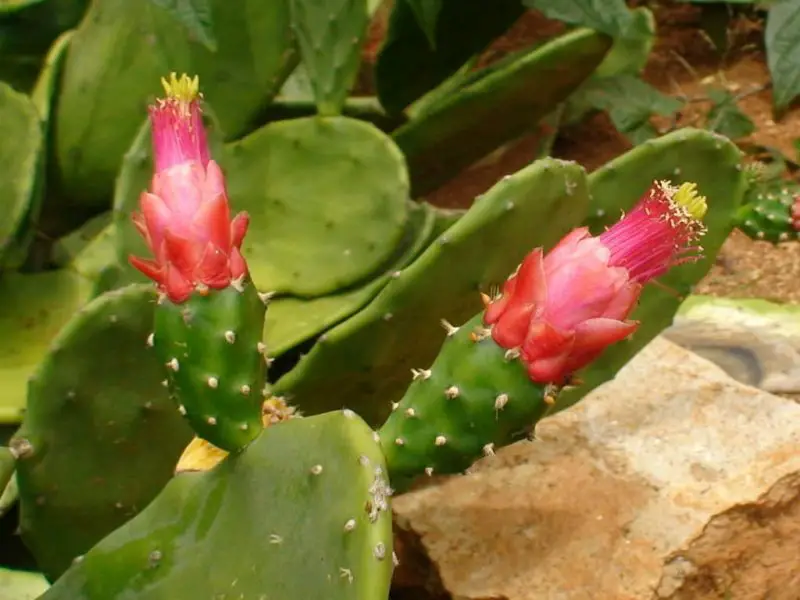
The Cochineal Nopal Cactus (Opuntia cochenillifera) is a fast-growing, pad-forming cactus traditionally cultivated for cochineal insects, which produce a natural red dye. It has smooth, green pads with few spines, making it easier to handle than other prickly pear species. It also produces bright red flowers that develop into edible fruit.
Native to Central and South America, this cactus thrives in warm, arid climates with well-draining soil. It is highly drought-tolerant and can be used in landscaping, erosion control, or as a food source. In addition to its economic importance in dye production, its pads and fruit are consumed in various culinary dishes.
Dinosaur Back Plant
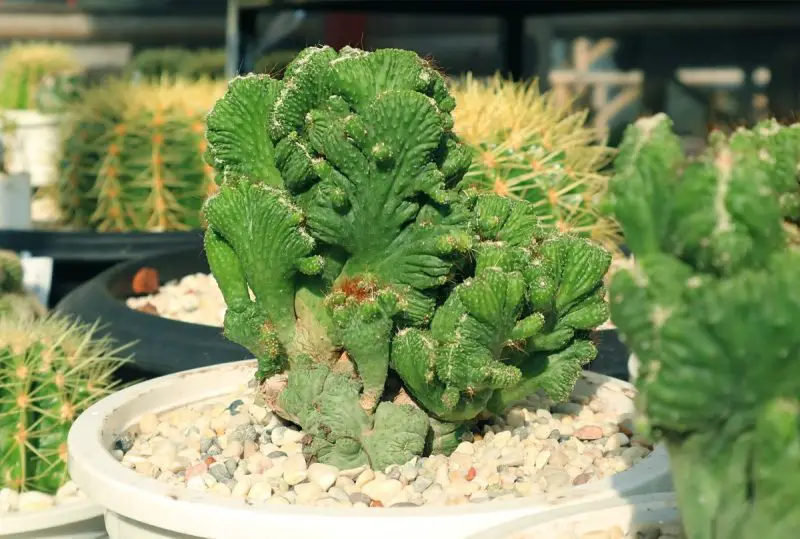
The Dinosaur Back Plant (Myrtillocactus eichlamii) is a unique, sculptural cactus with thick, ribbed stems that resemble the rough, plated skin of a dinosaur. It forms a shrubby or tree-like structure, reaching heights of up to 15 feet. Its deep green, wavy ridges give it a prehistoric appearance, making it a striking addition to desert landscapes.
Native to Guatemala and Mexico, this cactus thrives in full sun and well-draining soil. It is highly drought-resistant and requires minimal care. In spring, it produces small white flowers followed by dark purple, berry-like fruit. Its unusual texture and distinctive form make it a favorite among collectors and landscape designers looking for dramatic desert plants.
Paper Spine Cactus
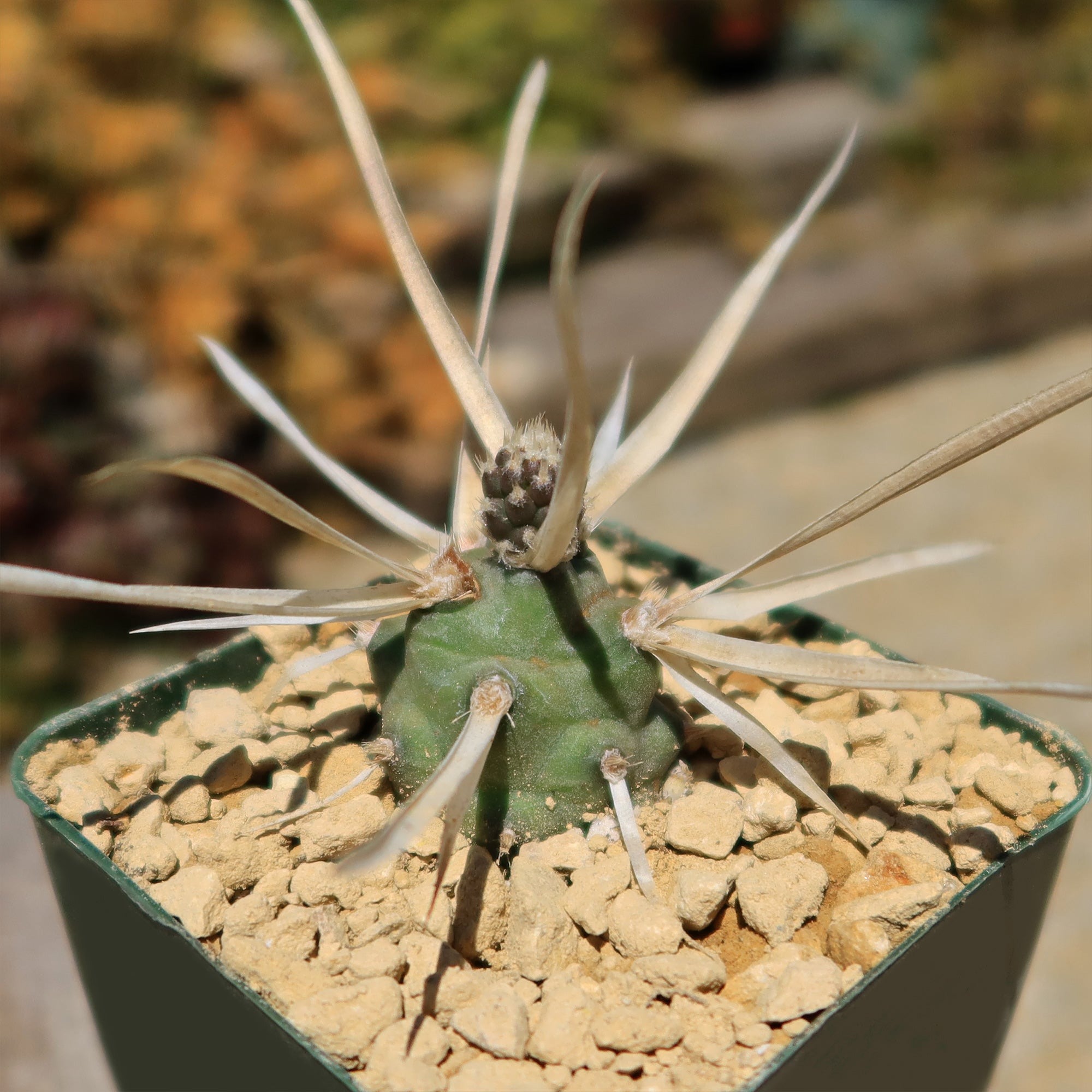
The Paper Spine Cactus (Tephrocactus articulatus) is a unique, segmented cactus known for its long, thin, papery spines that give it an unusual, delicate appearance. Its cylindrical stem segments easily detach and can propagate into new plants. The spines, while looking fragile, provide protection from herbivores.
Native to Argentina, this cactus thrives in well-draining, sandy soil and full sun. It is highly drought-tolerant, requiring minimal water. In spring, it produces small, pale yellow or white flowers. Due to its fragile segments, it is best grown in containers or rock gardens where it won’t be easily disturbed.
Baby Toes Cactus

The Baby Toes Cactus (Fenestraria rhopalophylla) is a small, succulent-like cactus with finger-shaped leaves that resemble tiny toes. Its translucent tips allow sunlight to reach deeper tissue, aiding in photosynthesis. This compact plant remains low to the ground and spreads gradually over time.
Native to South Africa and Namibia, this cactus thrives in bright, indirect sunlight and well-draining soil. It requires minimal water, as overwatering can cause root rot. In the right conditions, it produces small, daisy-like white or yellow flowers. Its unique shape and easy-care nature make it a popular houseplant.
Azure Cactus
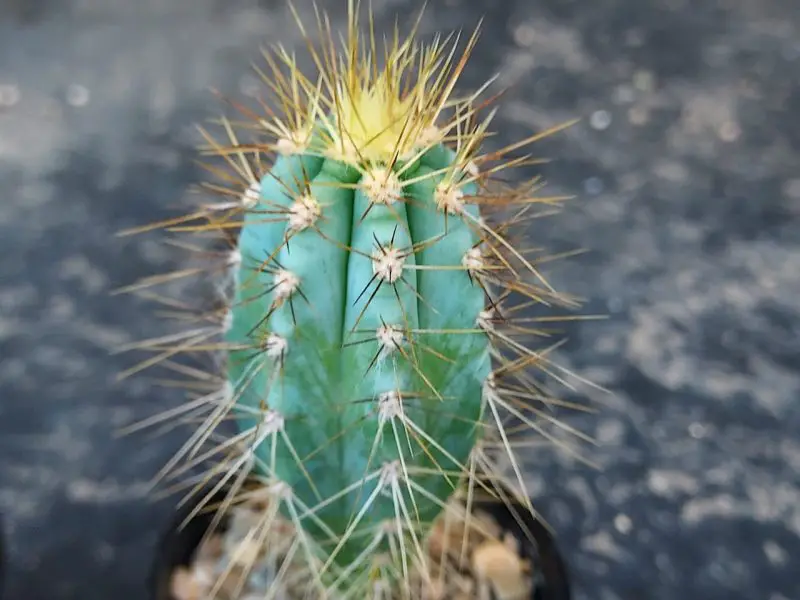
The Azure Cactus (Pilosocereus azureus), also known as the Blue Torch Cactus, is a striking columnar cactus with a vibrant blue hue and golden spines. Its tall, upright stems develop a waxy coating that enhances their blue color. At maturity, it produces large, white, nocturnal flowers.
Native to Brazil, this cactus thrives in full sun and sandy, well-draining soil. It is drought-resistant and prefers infrequent watering. Its stunning blue coloration and fast-growing nature make it a sought-after ornamental plant for arid gardens and container cultivation.
Rainbow Cactus

The Rainbow Cactus (Echinocereus rigidissimus) is a small, cylindrical cactus known for its colorful, banded spines in shades of pink, yellow, and white. As it matures, the color intensifies, giving it a vibrant, rainbow-like appearance. It remains compact, reaching about 12 inches in height.
Native to the southwestern United States and northern Mexico, this cactus prefers well-draining soil and full sun. It blooms in summer, producing large, bright pink flowers with yellow centers. Due to its small size and striking coloration, it is a popular choice for rock gardens and potted collections.
Shaving Brush Cactus
The Shaving Brush Cactus (Pseudobombax ellipticum) is named for its large, brush-like flowers, which resemble a shaving brush with long, filament-like petals in shades of pink or white. It has a thick, swollen base that stores water, helping it survive drought conditions.
Native to Central America, this unique cactus prefers warm temperatures and well-draining soil. It is often grown as an ornamental tree in tropical regions. When not in bloom, its sculptural trunk and sparse branches give it an intriguing, bonsai-like appearance.
Brazilian Prickly Pear
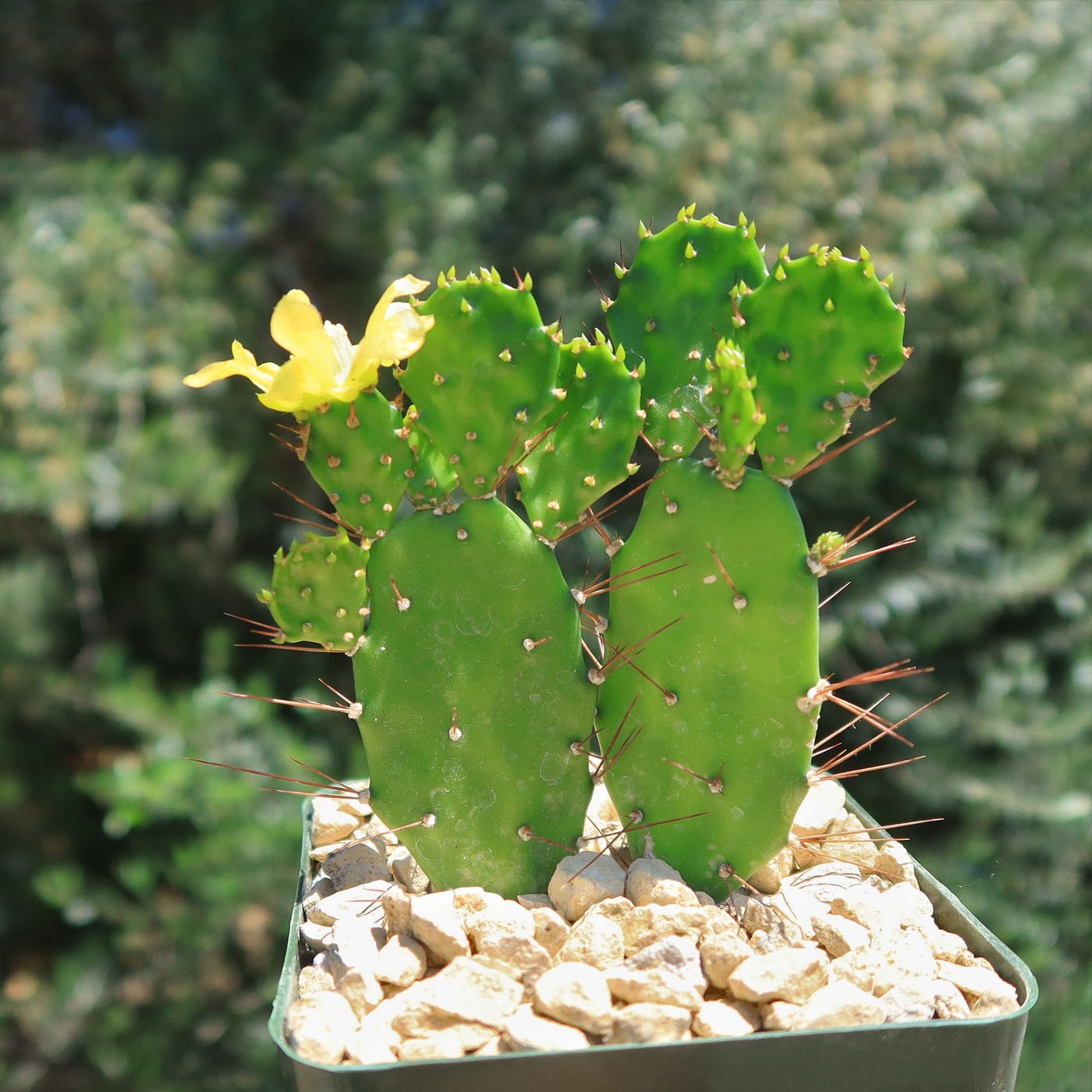
The Brazilian Prickly Pear (Opuntia brasiliensis) is a tree-like prickly pear species with large, oval pads that can grow up to 15 feet tall. It has a more upright growth habit than other Opuntia species, with fewer but sharper spines. During summer, it produces yellow flowers that develop into edible, red fruit.
Native to Brazil, this cactus thrives in hot, dry climates with well-draining soil. It is drought-tolerant and requires minimal maintenance. Its tall, structured growth and edible fruit make it a valuable addition to xeriscape gardens and sustainable landscapes.
Blue Barrel Cactus
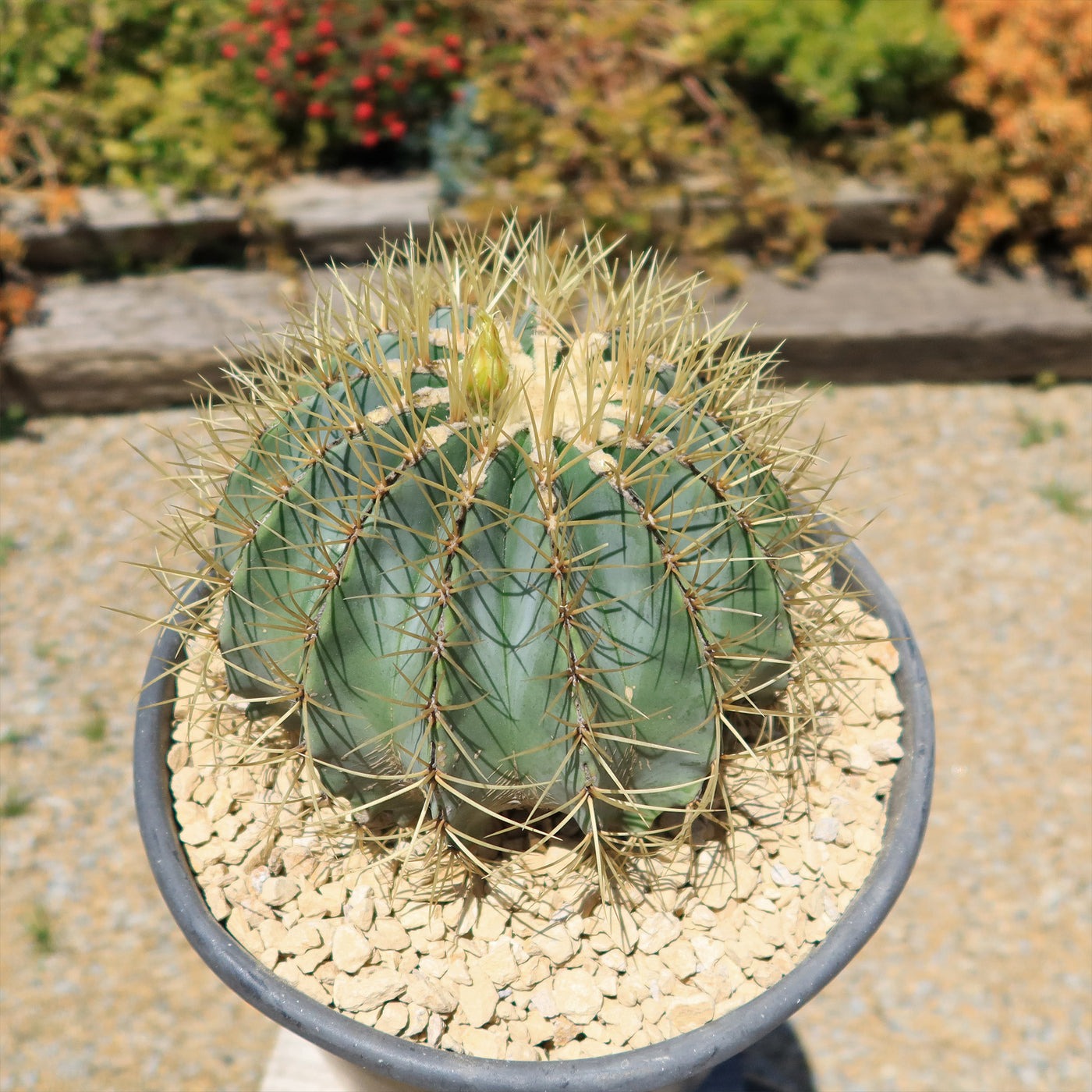
The Blue Barrel Cactus (Ferocactus glaucescens) is a round, slow-growing cactus with a striking blue-green hue and prominent golden spines. It forms a symmetrical, barrel-shaped body that can reach up to 2 feet in height and width. In late spring, it produces yellow flowers, followed by small, edible fruit.
Native to central Mexico, this cactus thrives in dry, rocky soils with full sun exposure. It is highly drought-tolerant and well-suited for desert landscapes, rock gardens, and container planting. Its unique bluish coloration and low-maintenance nature make it a favorite among collectors.
Miniature Barrel Cactus

The Miniature Barrel Cactus (Parodia magnifica), also known as the Ball Cactus, is a small, globe-shaped species with vertical ribs lined with soft, golden spines. It remains compact, typically reaching about 6 inches in height, but can form clumps over time. In summer, it blooms with bright yellow flowers.
Native to Brazil and Argentina, this cactus prefers well-draining soil and bright, indirect sunlight. It requires minimal watering and thrives in warm, arid conditions. Its small size and appealing shape make it an excellent choice for indoor succulent collections and decorative pots.
Cow Tongue Prickly Pear
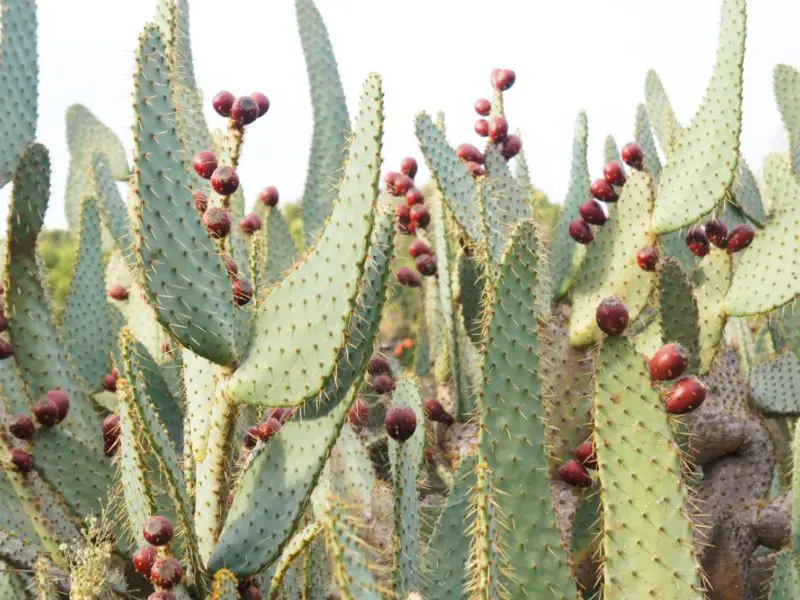
The Cow Tongue Prickly Pear (Opuntia linguiformis) is a distinctive prickly pear species with elongated, flattened pads that resemble the shape of a cow’s tongue. The pads are smooth, green, and often grow up to 2 feet long. During spring and summer, it produces large, yellow flowers, followed by red, edible fruit.
Native to Texas and northern Mexico, this cactus thrives in well-draining soil and full sun. It is highly drought-tolerant and spreads easily in arid environments. Its unusual pad shape and striking flowers make it a unique addition to xeriscape gardens.
Glass Ball Cactus
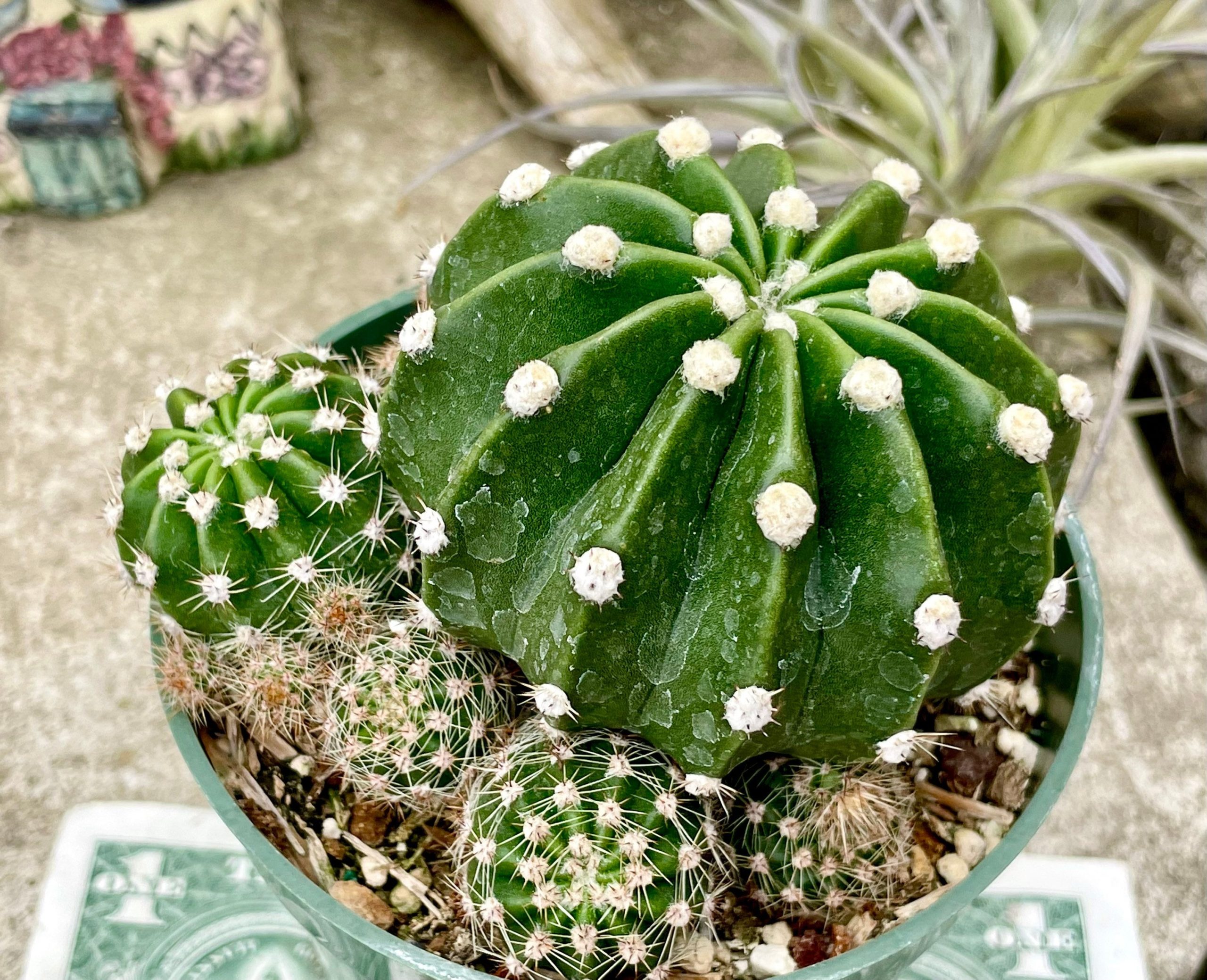
The Glass Ball Cactus (Echinopsis subdenudata) is a small, round cactus with a nearly spineless surface and a soft, green body. It gets its name from its smooth, glossy appearance. In summer, it produces large, fragrant white flowers that bloom at night.
Native to Bolivia and Paraguay, this cactus thrives in bright, indirect light and well-draining soil. It requires minimal watering and is highly resistant to drought. Its lack of sharp spines and attractive night-blooming flowers make it a popular indoor plant.
Twin-Spined Cactus
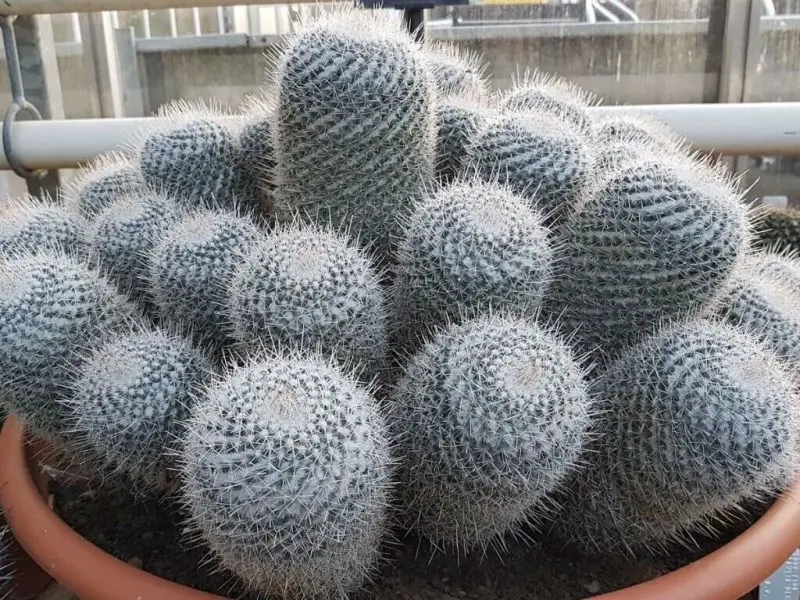
The Twin-Spined Cactus (Mammillaria geminispina) is a small, clumping cactus known for its dense covering of white, hair-like spines and bright red flowers. The name “twin-spined” refers to the paired arrangement of its spines on each tubercle. It forms rounded clusters that can grow up to 12 inches wide.
Native to central Mexico, this cactus prefers dry, well-draining soil and full sun to partial shade. It is highly drought-tolerant and thrives in desert environments. Its soft, fuzzy appearance and colorful flowers make it a favorite among collectors and rock garden enthusiasts.
Giant Saguaro Cactus
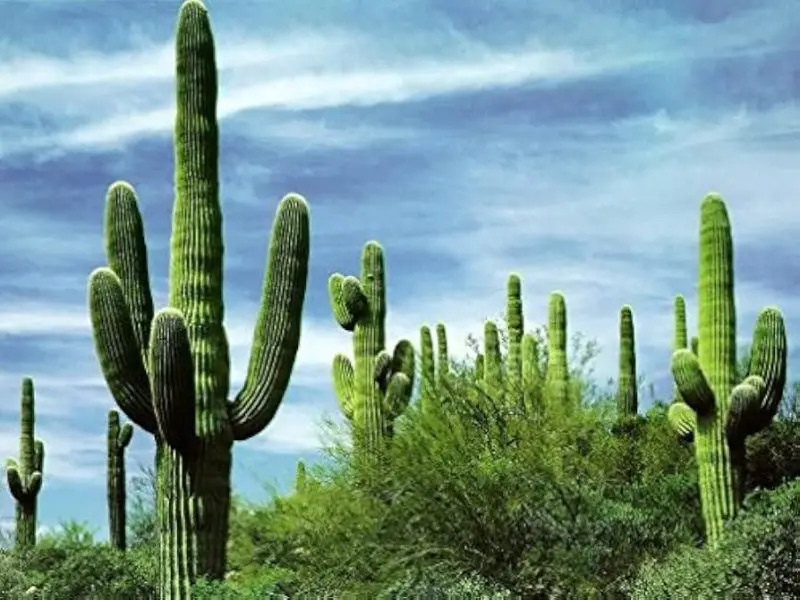
The Giant Saguaro Cactus (Carnegiea gigantea) is the most iconic cactus of the American Southwest, known for its towering height and branching arms. It can reach up to 40 feet tall and live for over 150 years. It has thick, ribbed stems covered in spines and stores large amounts of water to survive long droughts.
Native to the Sonoran Desert in Arizona and Mexico, the saguaro thrives in sandy, well-draining soil and requires full sun. It produces white, night-blooming flowers in late spring, followed by red, edible fruit. As a keystone species, it provides food and shelter for desert wildlife, making it a crucial part of its ecosystem.
Desert Pinwheel Cactus
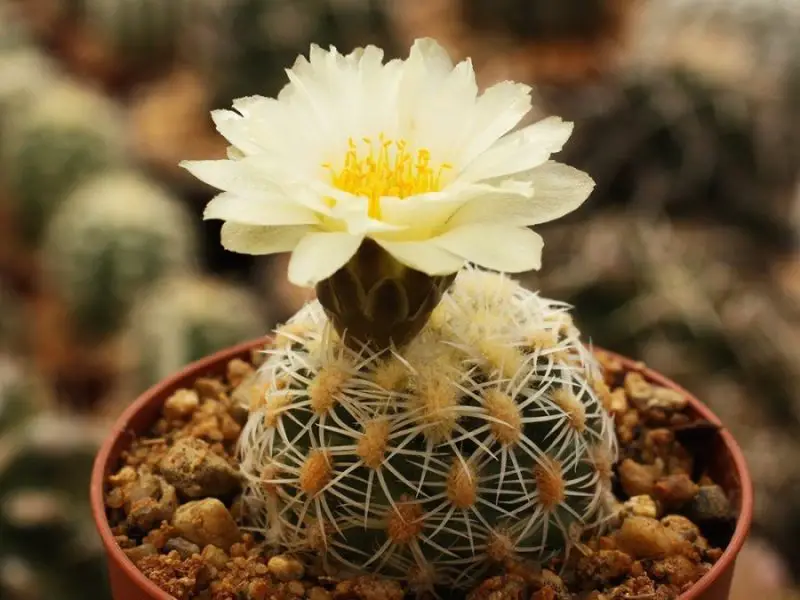
The Desert Pinwheel Cactus (Pediocactus bradyi) is a small, globular cactus with tightly arranged spines that form a striking pinwheel-like pattern. It remains low to the ground, rarely exceeding a few inches in height, and blends well into its arid surroundings. In spring, it produces delicate pink or purple flowers that contrast beautifully with its spiny body.
Native to the southwestern United States, this cactus thrives in rocky, well-draining soil and full sun. It is highly drought-resistant and adapted to extreme desert conditions. Due to its small size and unique spine arrangement, it is a prized addition to rock gardens and collectors’ displays.
Chilean Club Cactus
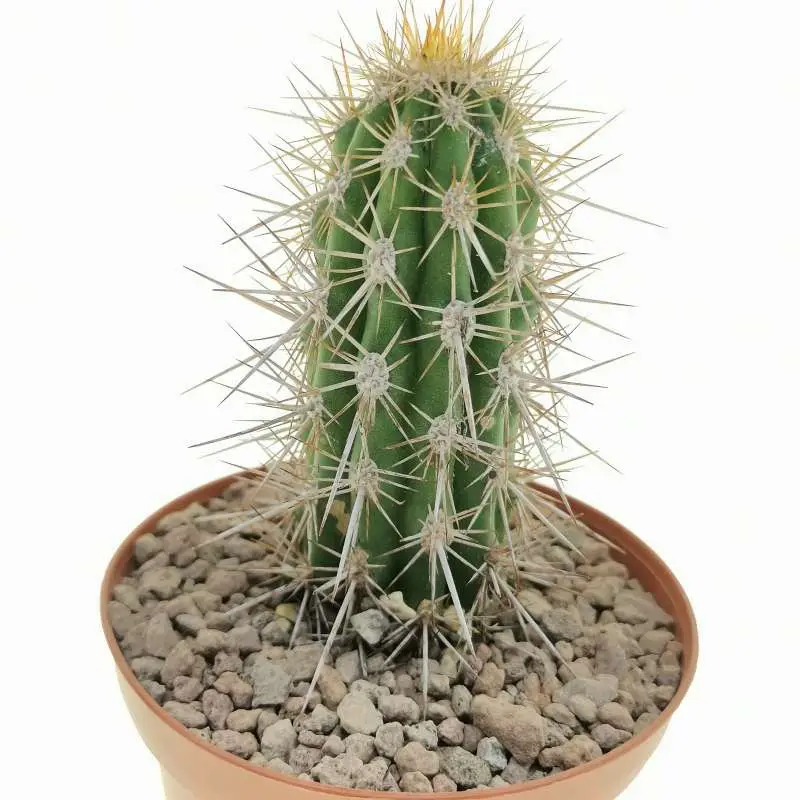
The Chilean Club Cactus (Eulychnia acida) is a tall, columnar cactus with a branching structure and dense clusters of spines. It can grow up to 13 feet tall and develops a rough, woody base as it matures. The cactus produces small, white to pink flowers that give way to edible fruit, known locally as “copao.”
Native to Chile, this cactus thrives in coastal desert environments with sandy, well-draining soil. It is highly drought-tolerant and benefits from full sun exposure. Its tall, tree-like growth and edible fruit make it an important plant for both ornamental and agricultural purposes.
Mexican Fence Post Cactus
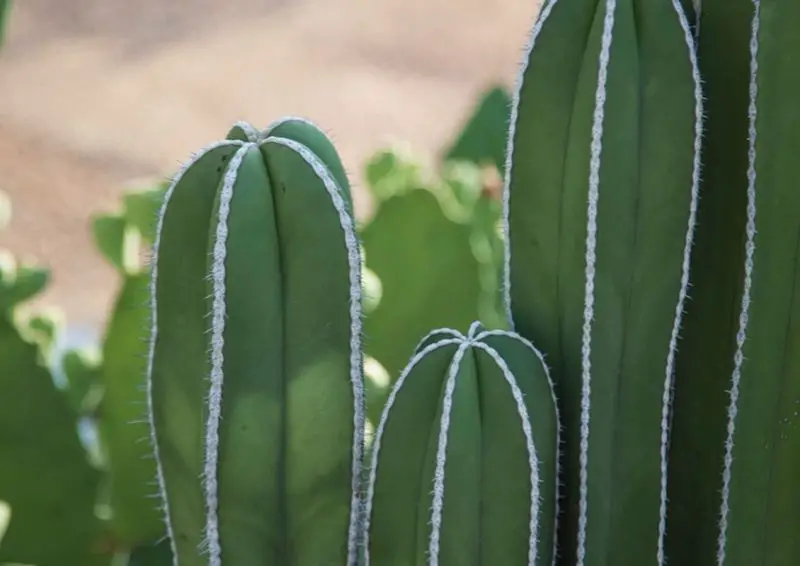
The Mexican Fence Post Cactus (Pachycereus marginatus) is a fast-growing, columnar cactus that can reach up to 20 feet tall. Its smooth, green stems have distinct vertical ridges lined with short, evenly spaced spines. As it matures, it produces pink or red flowers that develop into small, edible fruit.
Native to Mexico, this cactus thrives in hot, arid climates with well-draining soil. It is commonly used as a natural living fence due to its upright growth and resilience. Its architectural form and ease of care make it a popular choice for xeriscaping and desert landscapes.
Yellow Tower Cactus
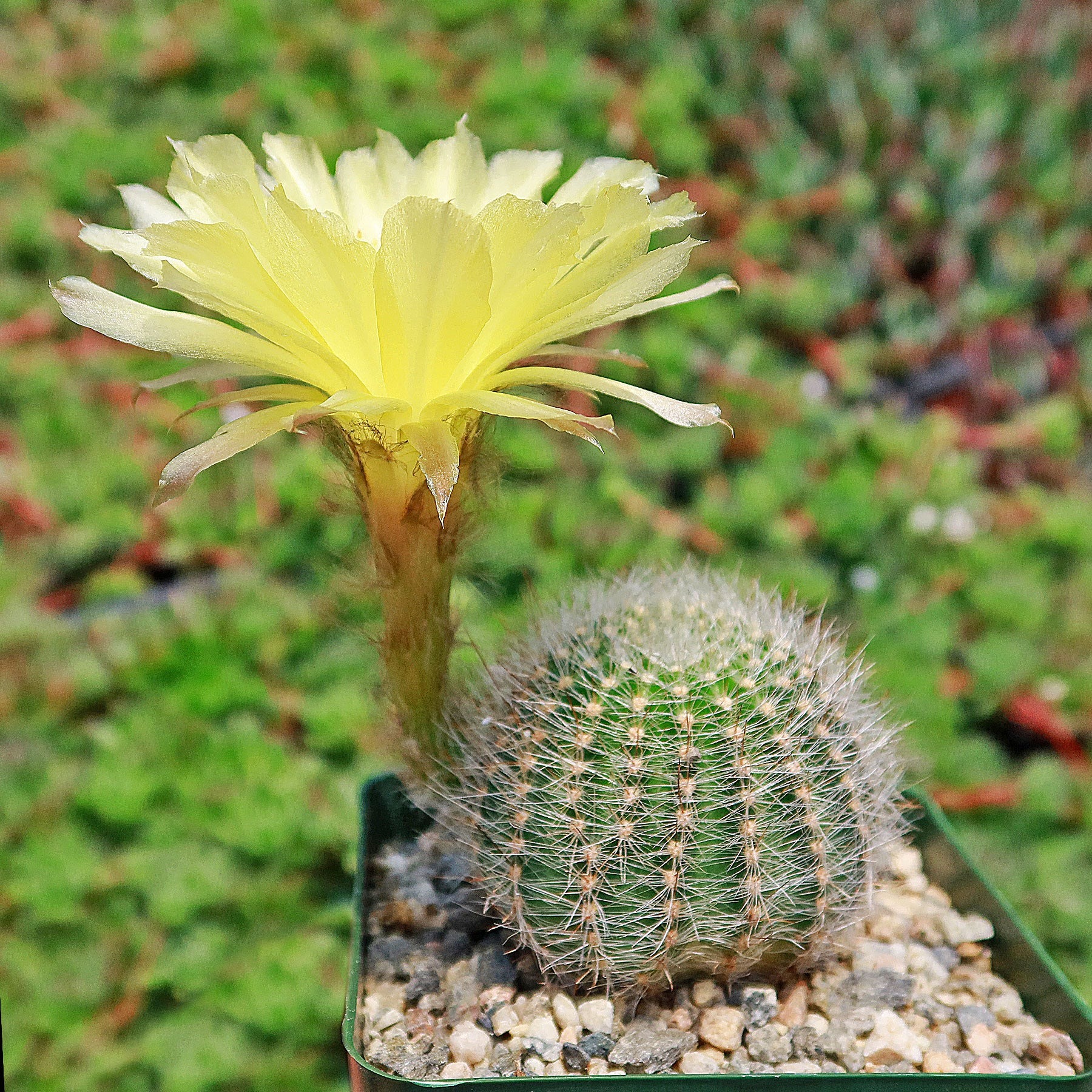
The Yellow Tower Cactus (Echinopsis aurea) is a small, cylindrical cactus known for its brilliant yellow flowers, which can cover the entire plant when in bloom. It has short, golden spines arranged along its vertical ridges and remains compact, usually reaching about 6 to 10 inches tall.
Native to Argentina, this cactus thrives in well-draining soil and full to partial sun. It is drought-tolerant and prefers occasional watering. Its bright flowers and small size make it a favorite among collectors and container gardeners.
Long Spine Barrel Cactus

The Long Spine Barrel Cactus (Ferocactus pilosus) is a large, rounded cactus distinguished by its long, curved, reddish spines that provide a striking contrast to its deep green body. It can grow up to 6 feet tall and produces yellow to orange flowers in summer, followed by small, fleshy fruit.
Native to Mexico, this cactus thrives in dry, rocky soils and full sun. It is highly drought-tolerant and well-adapted to harsh desert conditions. Its dramatic spines and sturdy barrel shape make it a standout in arid gardens and desert landscapes.
Red Cap Cactus
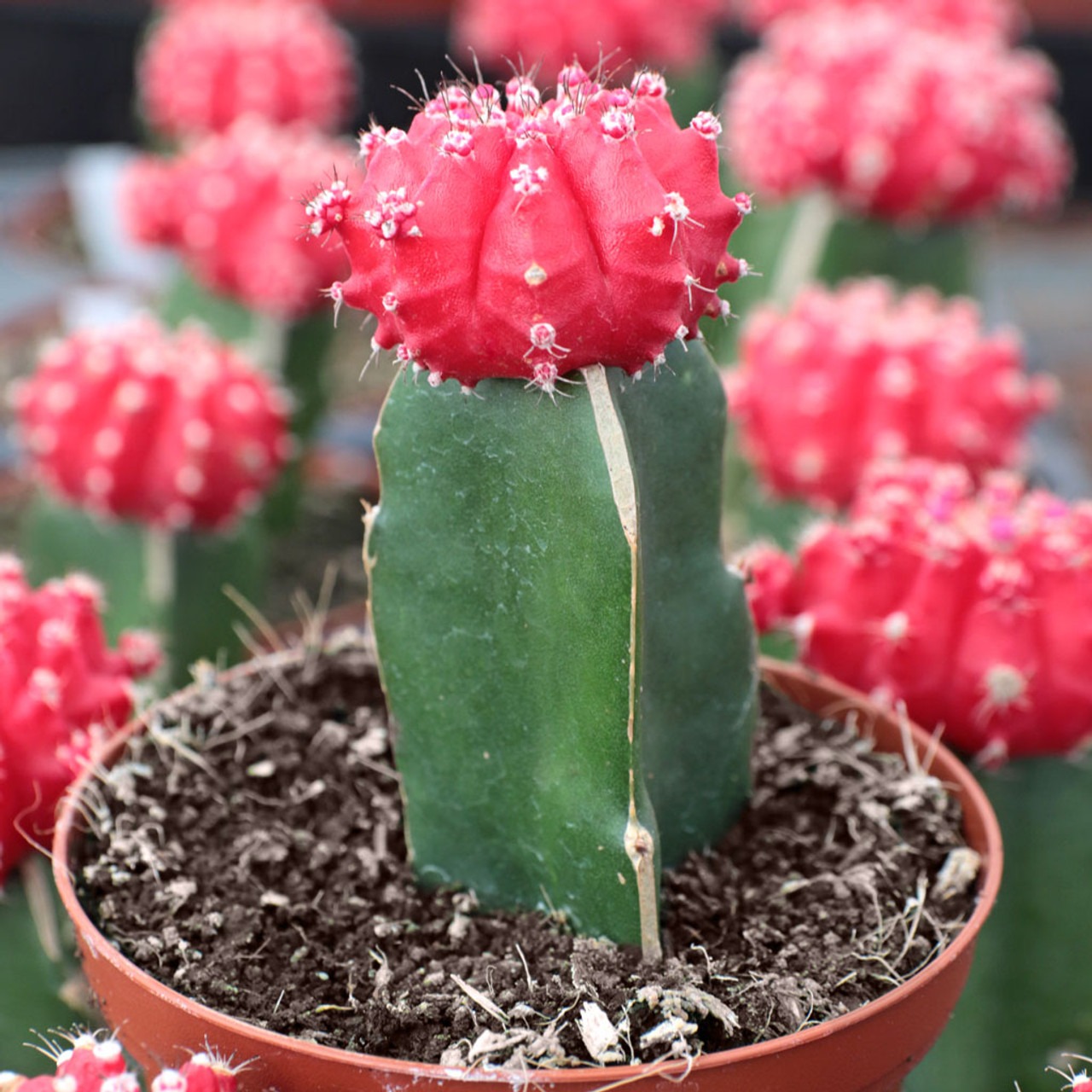
The Red Cap Cactus (Gymnocalycium mihanovichii), also known as the Moon Cactus, is a small, grafted cactus with a bright red, orange, or pink top. Because it lacks chlorophyll, it must be grafted onto a green cactus base to survive. Its round, ribbed structure and vibrant color make it a popular decorative plant.
Native to South America, this cactus thrives in bright, indirect light and well-draining soil. It requires minimal water and is often grown as an indoor plant. Its vivid, candy-like appearance makes it a favorite choice for home décor and succulent arrangements.
White Ghost Cactus
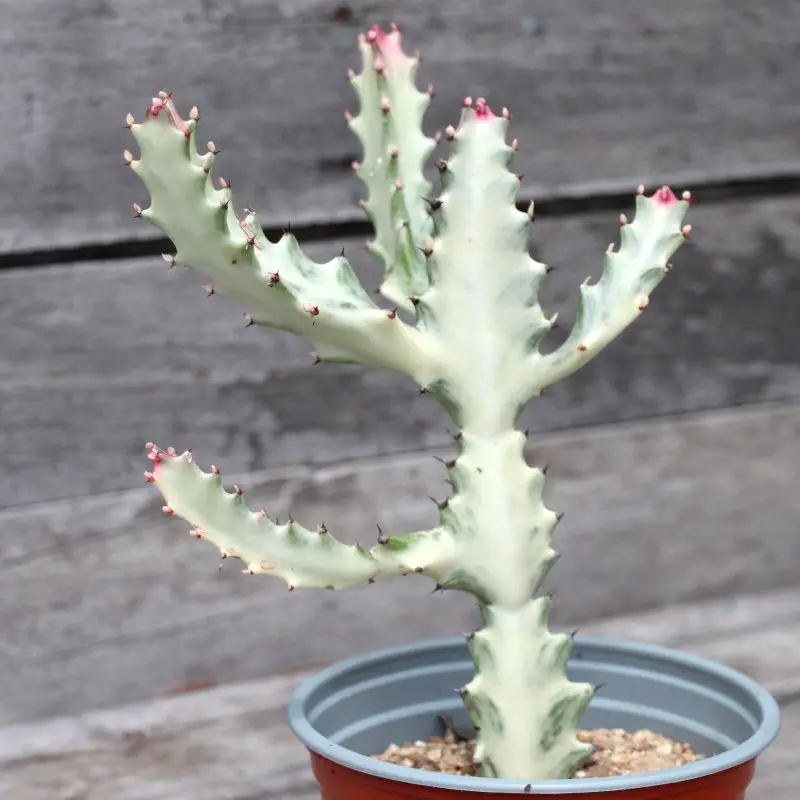
The White Ghost Cactus (Euphorbia lactea ‘White Ghost’) is a striking, almost entirely white cactus-like succulent with an eerie, ghostly appearance. Its upright, branching stems are covered in pale cream to pure white coloring, with occasional hints of green or pink. Unlike true cacti, it does not have spines but instead produces a milky sap when cut.
Native to tropical Asia, this plant thrives in warm, dry conditions with well-draining soil and bright, indirect light. It is often grown as an ornamental houseplant due to its unique coloration and sculptural form. However, care should be taken, as its sap can be toxic if ingested or touched.
Silver Ball Cactus
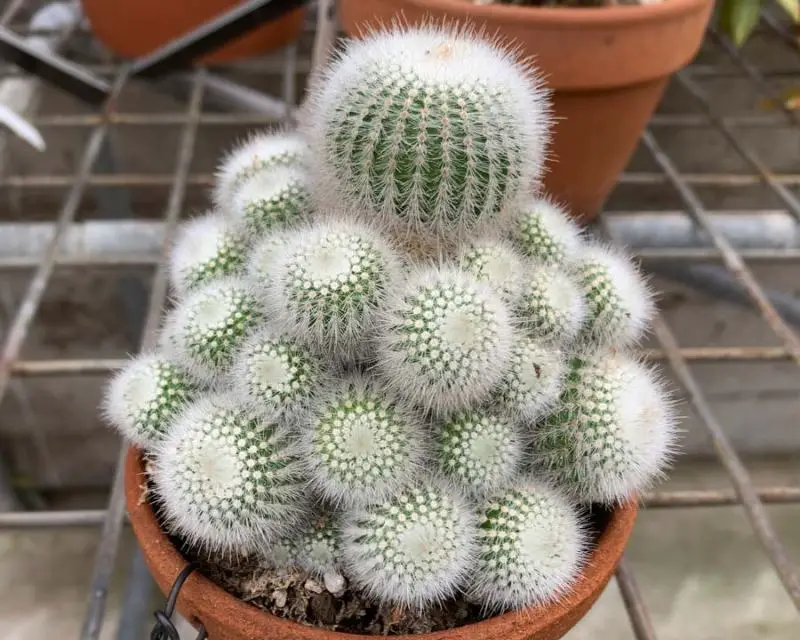
The Silver Ball Cactus (Parodia scopa) is a small, globular cactus with dense, silvery-white spines that give it a fuzzy, ball-like appearance. It grows in clusters and reaches about 6 inches in height. In the summer, it produces bright yellow or orange flowers that add a pop of color to its silvery spines.
Native to South America, particularly Brazil and Argentina, this cactus prefers well-draining soil and full sun to partial shade. It is drought-tolerant and well-suited for container gardens and rockeries. Its soft, woolly appearance makes it a favorite among collectors.
Golden Lace Cactus
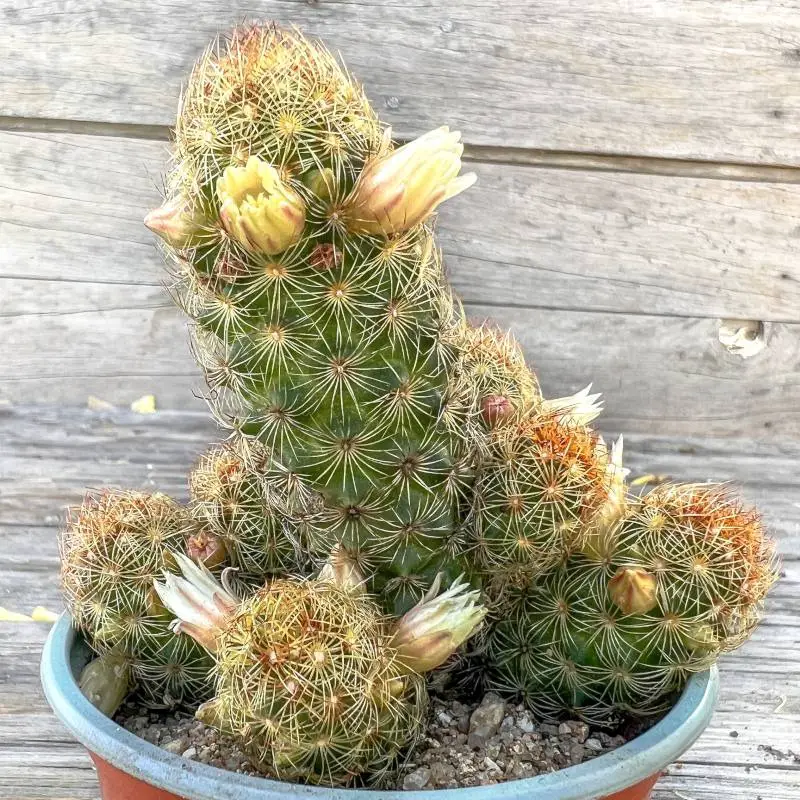
The Golden Lace Cactus (Mammillaria elongata) is a small, clumping cactus known for its long, cylindrical stems covered in dense, golden-yellow spines. The spines form an intricate, lace-like pattern that gives the plant its name. In spring, it produces small, delicate pink or white flowers along the tops of its stems.
Native to central Mexico, this cactus thrives in dry, rocky soils with full sun exposure. It is highly drought-tolerant and grows well in containers or rock gardens. Its golden spines and compact growth habit make it a beautiful, low-maintenance addition to any succulent collection.
Dwarf Chin Cactus
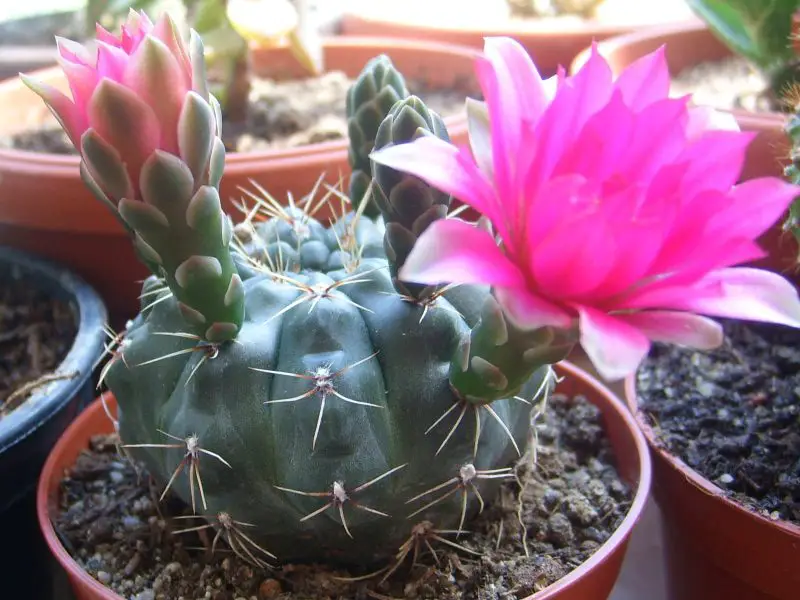
The Dwarf Chin Cactus (Gymnocalycium baldianum) is a small, round cactus with deep green, ribbed stems and short, curved spines. It remains compact, typically reaching only a few inches in height. In late spring and summer, it produces stunning, large red, pink, or orange flowers that contrast beautifully with its dark green body.
Native to Argentina, this cactus prefers well-draining soil and bright, indirect light. It is easy to care for, requiring minimal watering and tolerating dry conditions well. Its small size and showy blooms make it a favorite among cactus enthusiasts.
Dog Tail Cactus
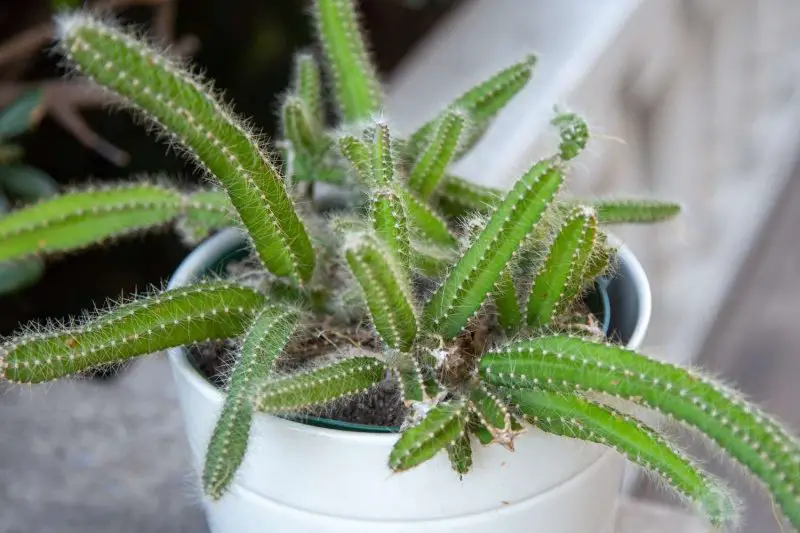
The Dog Tail Cactus (Strophocactus testudo), named for its long, trailing stems resembling a dog’s tail, is a fast-growing, epiphytic cactus. Its stems can grow several feet long, making it ideal for hanging baskets. During summer, it produces large, fragrant, white flowers that bloom at night.
Native to Central and South America, this cactus thrives in humid, tropical environments and prefers bright, indirect light. Unlike desert cacti, it requires more frequent watering. Its trailing habit and stunning night-blooming flowers make it a unique and attractive houseplant.
Orange Cob Cactus
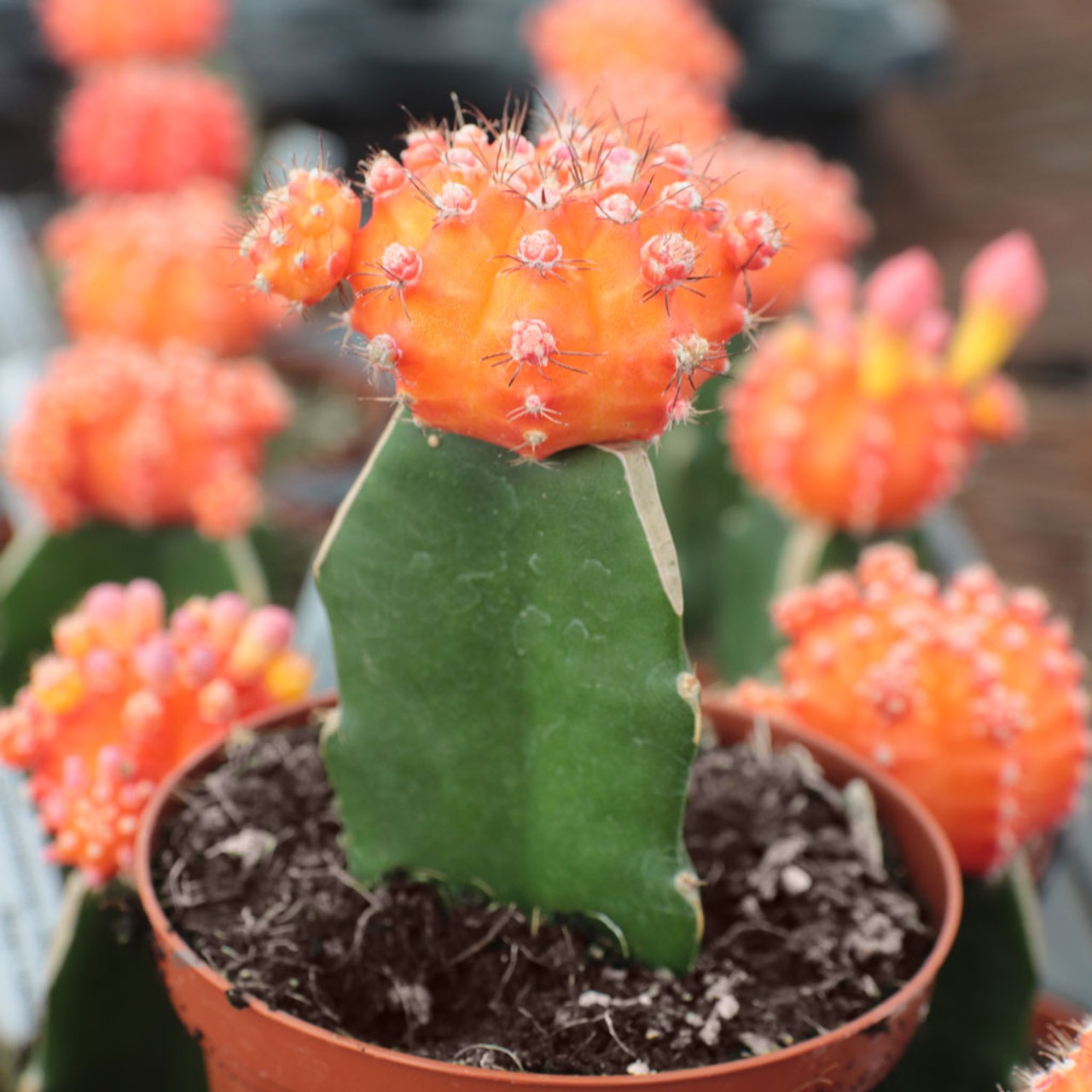
The Orange Cob Cactus (Gymnocalycium mihanovichii var.) is a brightly colored, grafted cactus with an orange, rounded top that lacks chlorophyll. It must be grafted onto a green base cactus to survive. The vibrant, cob-like structure and ribbed texture make it a popular decorative plant.
Native to South America, this cactus thrives in warm, dry conditions with well-draining soil and indirect light. It is commonly kept as an indoor plant due to its small size and striking color. Its cheerful orange hue makes it a favorite for adding a pop of color to succulent arrangements.
Club Cholla Cactus
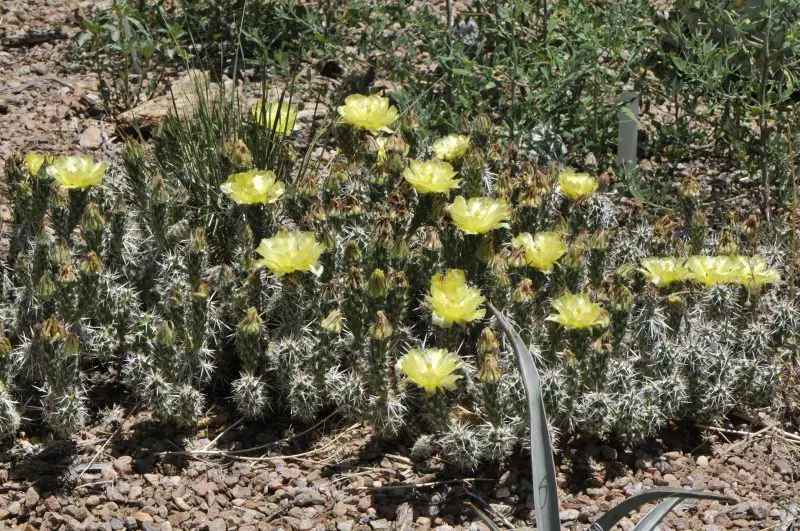
The Club Cholla Cactus (Grusonia clavata) is a low-growing, spreading cactus with club-shaped segments covered in dense, sharp spines. It forms thick mats over time, making it an excellent ground cover in arid landscapes. Its small, yellowish-green flowers bloom in the spring, followed by spiny fruit.
Native to the southwestern United States and northern Mexico, this cactus thrives in dry, rocky soils with full sun exposure. It is highly drought-tolerant and adapted to extreme desert conditions. Due to its spiny nature, it should be handled with care when planting or maintaining.
Lamb’s Tail Cactus
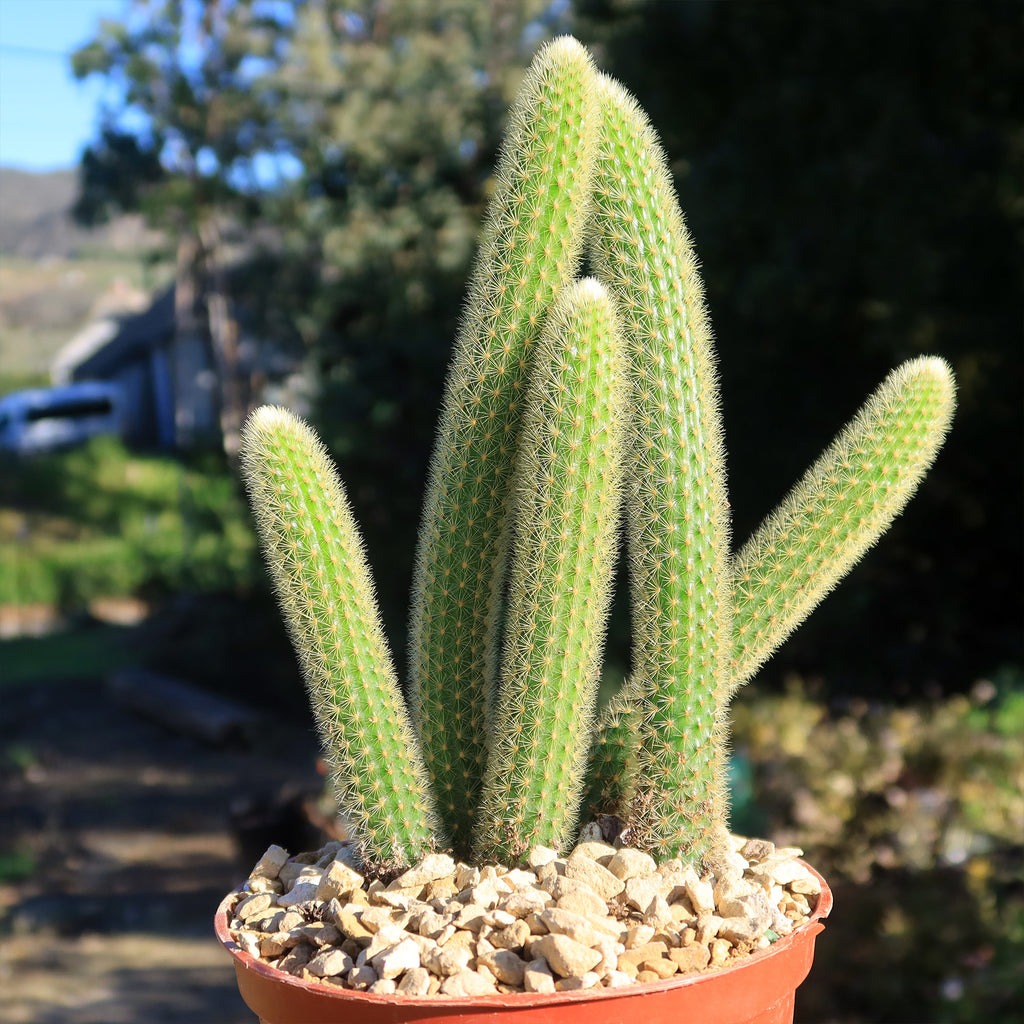
The Lamb’s Tail Cactus (Cleistocactus winteri) is a trailing cactus with long, cascading stems covered in soft, golden spines. Its fuzzy appearance resembles a lamb’s tail, giving it its common name. In spring and summer, it produces bright orange or pink tubular flowers along its stems.
Native to Bolivia, this cactus thrives in warm, dry climates and prefers well-draining soil with bright, indirect sunlight. It is a popular choice for hanging baskets due to its trailing growth habit. While drought-tolerant, it benefits from occasional watering during the growing season.
Blue Candle Cactus
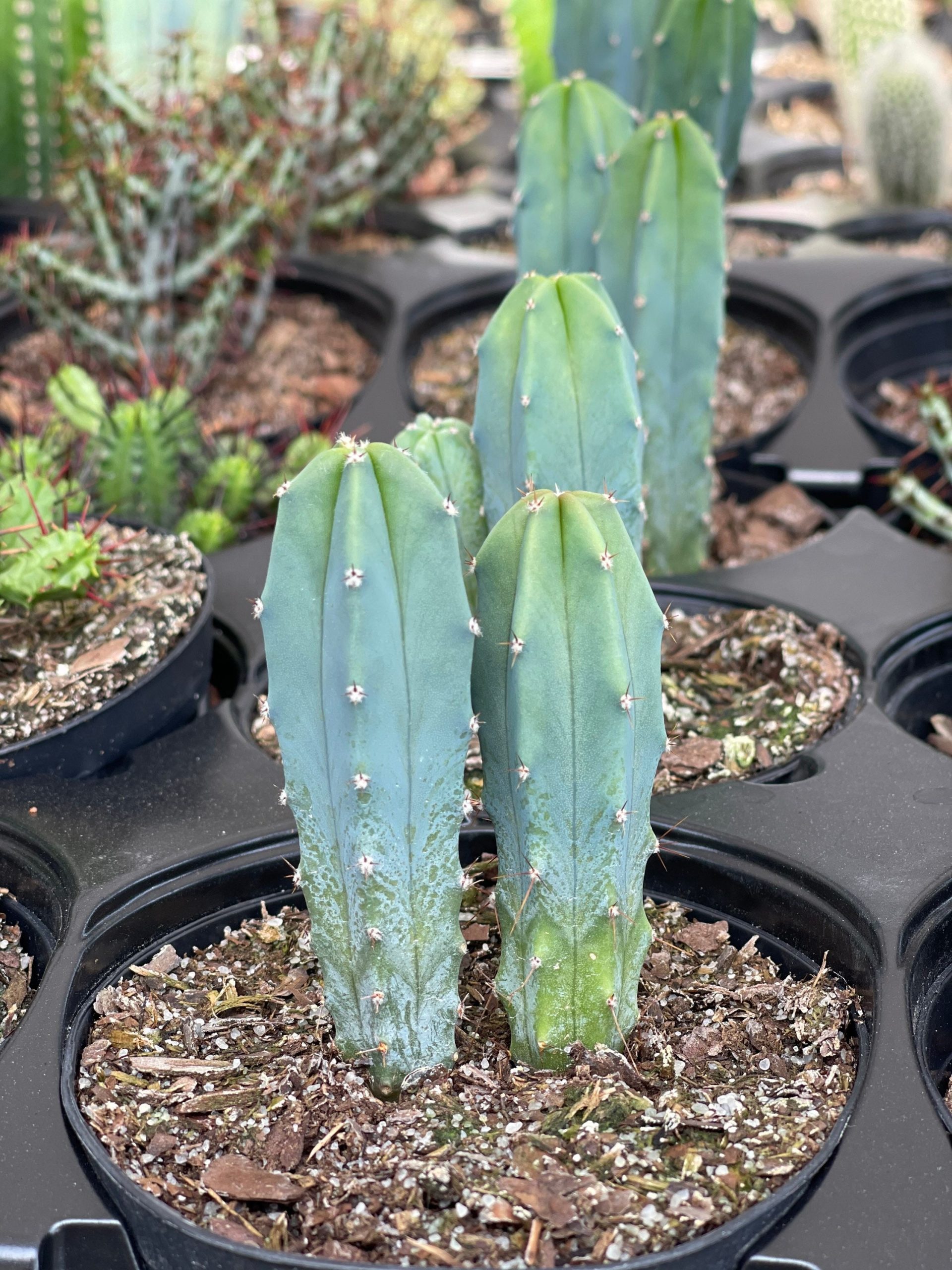
The Blue Candle Cactus (Myrtillocactus geometrizans) is a fast-growing, columnar cactus with a striking blue-green hue. It can grow up to 15 feet tall, with multiple branches forming a candelabra-like shape. In spring, it produces small, white flowers that develop into edible, blueberry-like fruit.
Native to Mexico, this cactus thrives in well-draining soil and full sun. It is drought-tolerant and an excellent choice for xeriscaping. Its striking blue color and architectural form make it a standout in desert gardens and landscapes.
Peanut Cactus
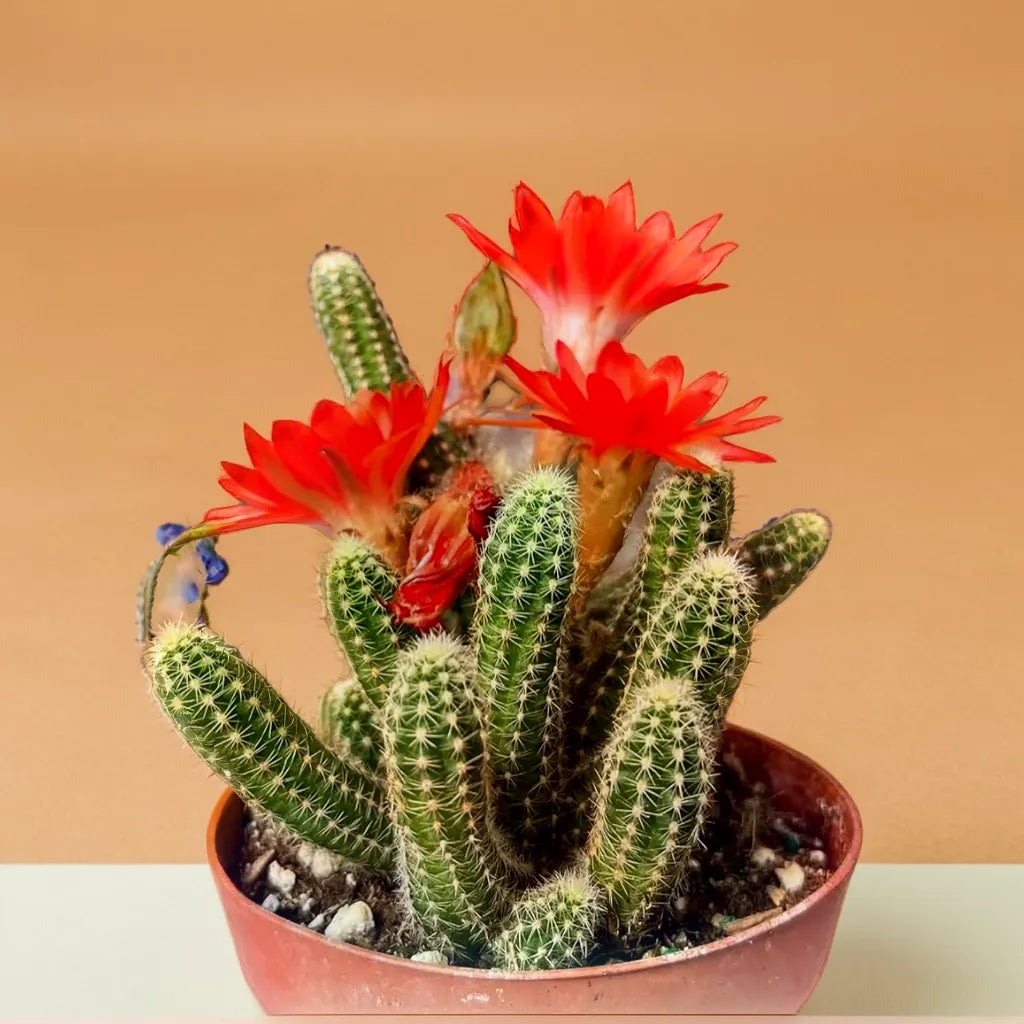
The Peanut Cactus (Chamaecereus silvestrii) is a small, clumping cactus with thin, finger-like stems covered in soft spines. It spreads quickly, forming dense clusters that resemble a pile of peanuts. In late spring and early summer, it produces brilliant red or orange flowers.
Native to Argentina, this cactus thrives in well-draining soil and prefers bright, indirect light. It is well-suited for container gardening and hanging baskets due to its trailing habit. Easy to care for, it requires minimal watering and can tolerate short periods of drought.
Old Man of the Andes Cactus
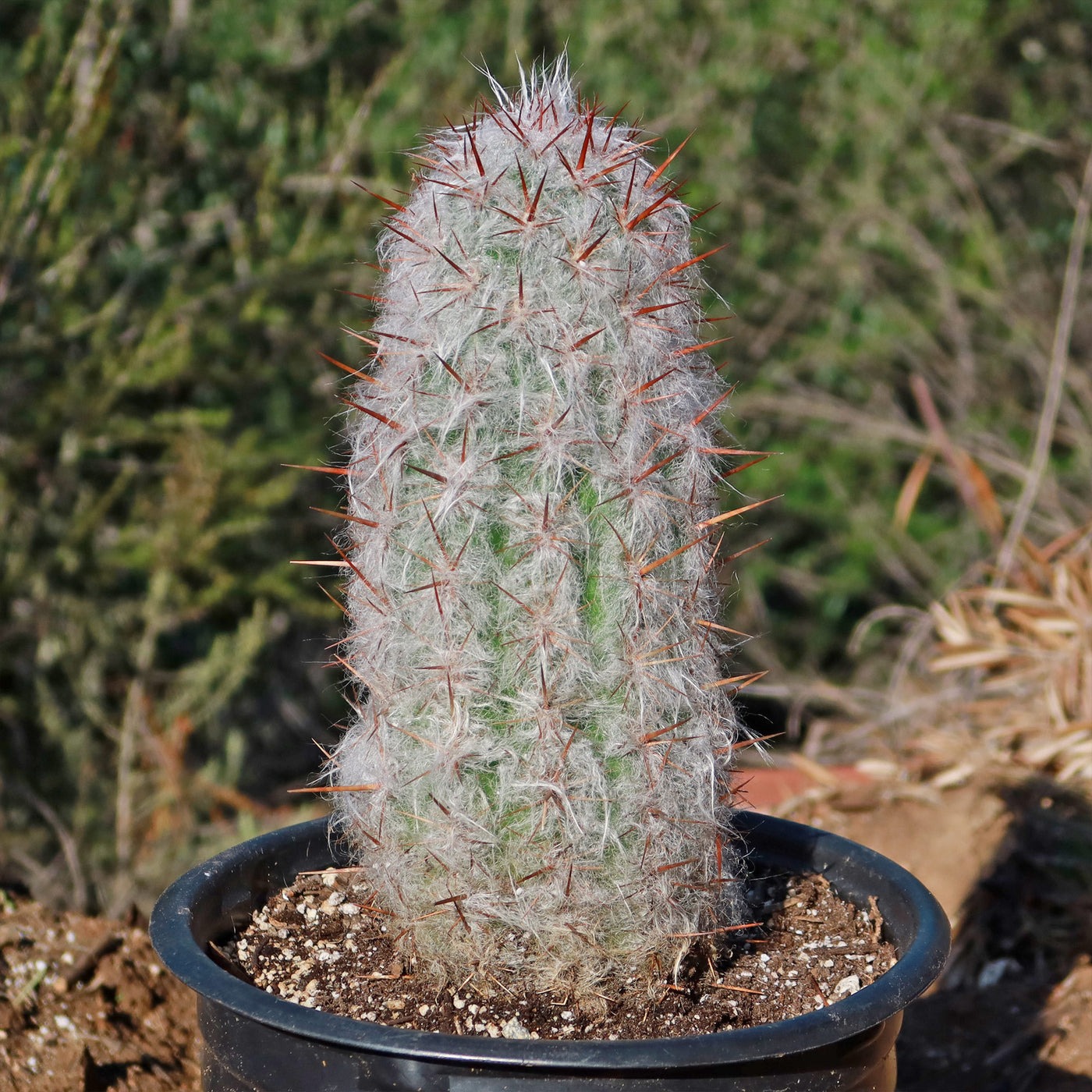
The Old Man of the Andes Cactus (Oreocereus celsianus) is a columnar cactus covered in a thick layer of white, woolly hairs that help protect it from harsh mountain climates. It grows slowly, reaching heights of up to 10 feet over time. In summer, it produces red or pink flowers near the tops of its stems.
Native to the high-altitude regions of the Andes, this cactus thrives in well-draining, rocky soil and full sun. It is highly drought-tolerant but benefits from occasional watering during the growing season. Its unique, shaggy appearance makes it a favorite among collectors.







My small 5 inch tall cactus shoots out a 3 foot tall stalk of small pink and green blossoms all up the stalk and that stalk sends out another smaller stalk on each side with the same blossoms. It belonged to a friend who passed away and I can’t find any information on it.